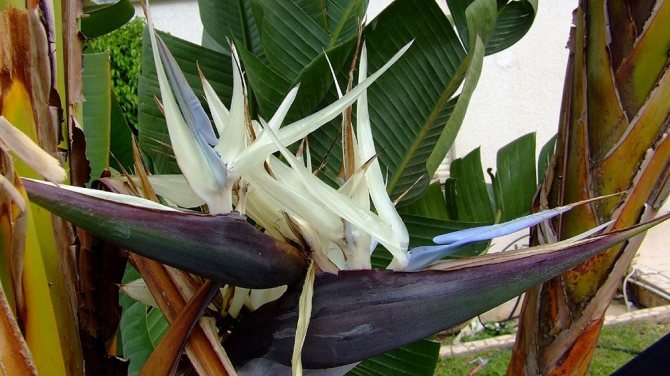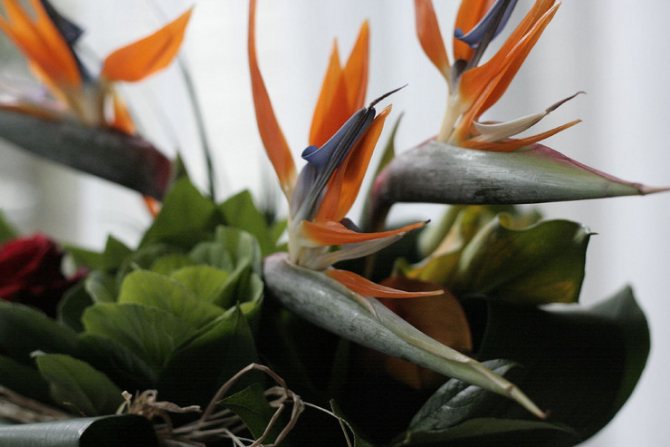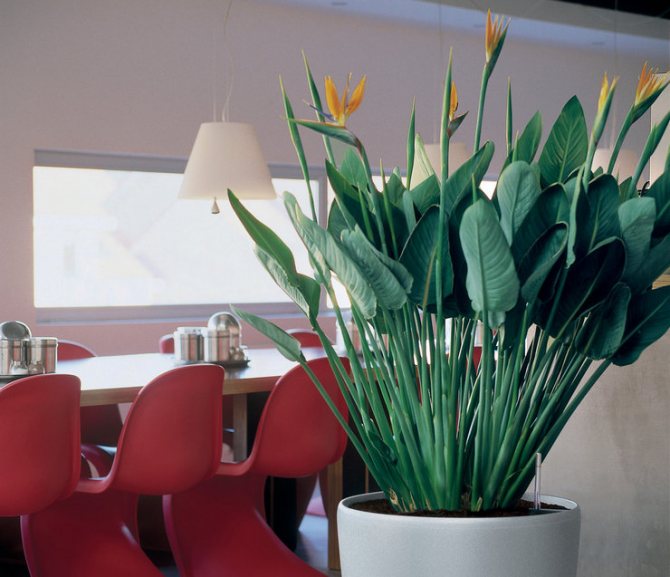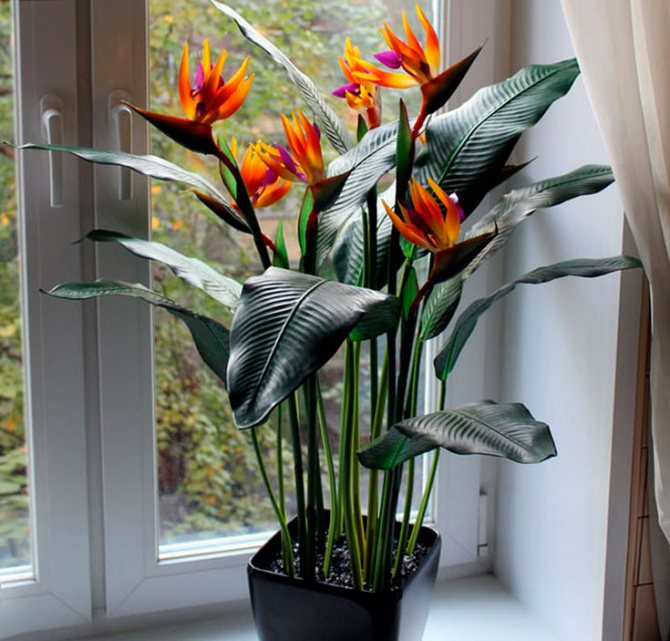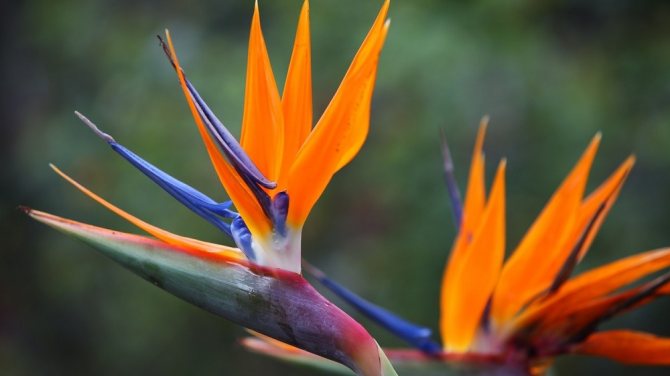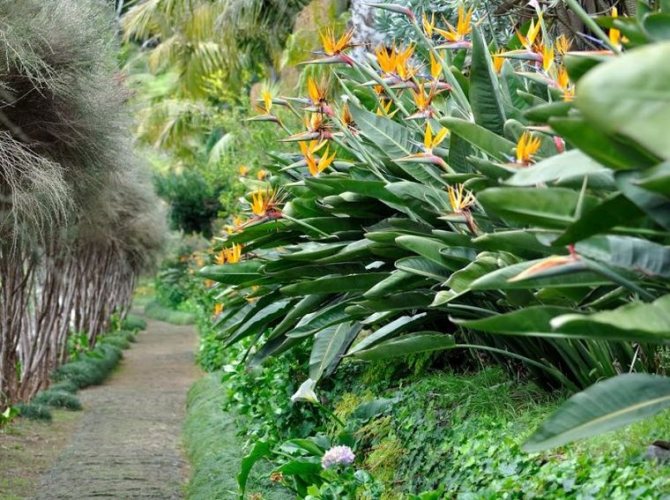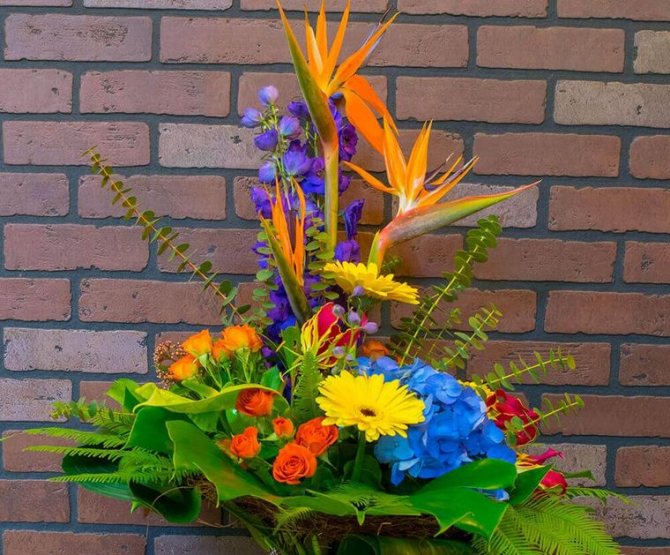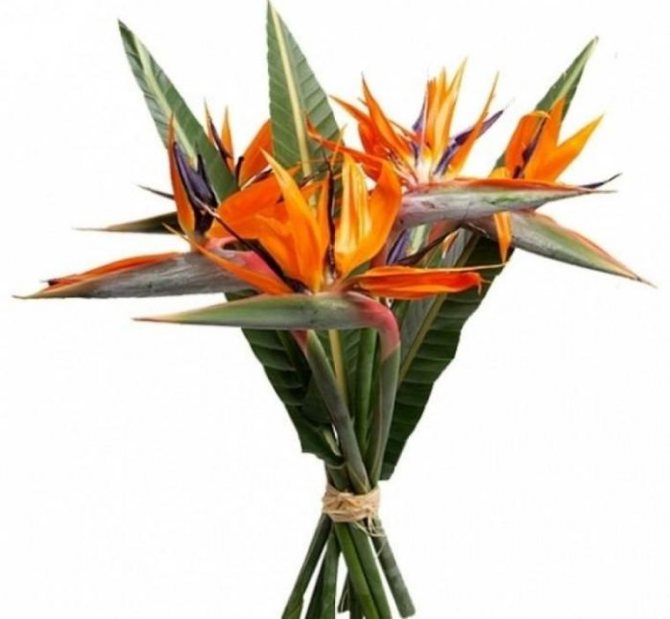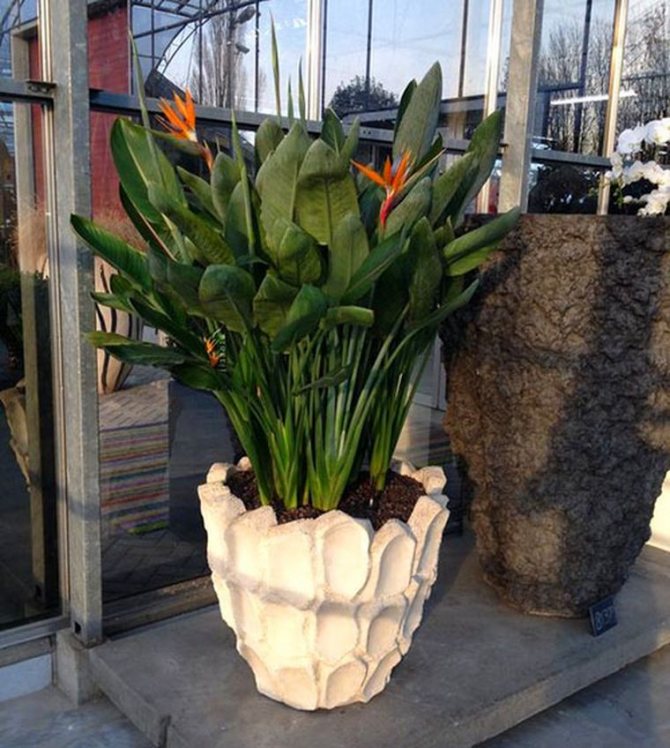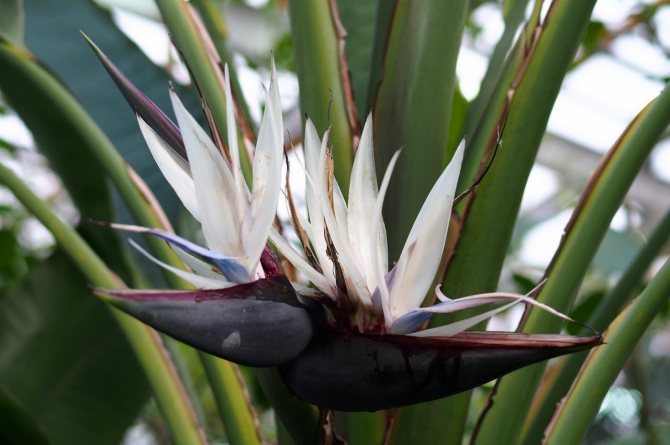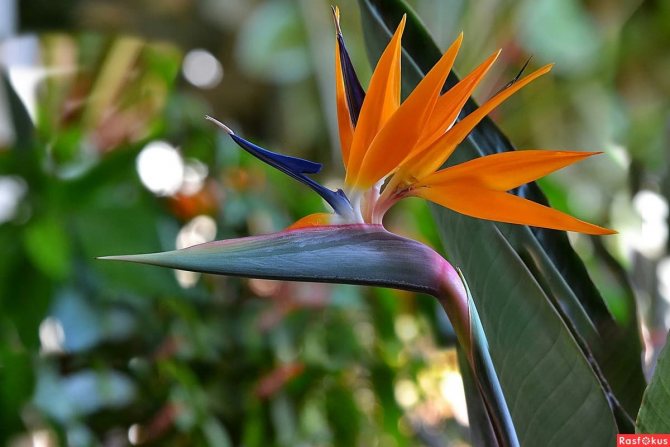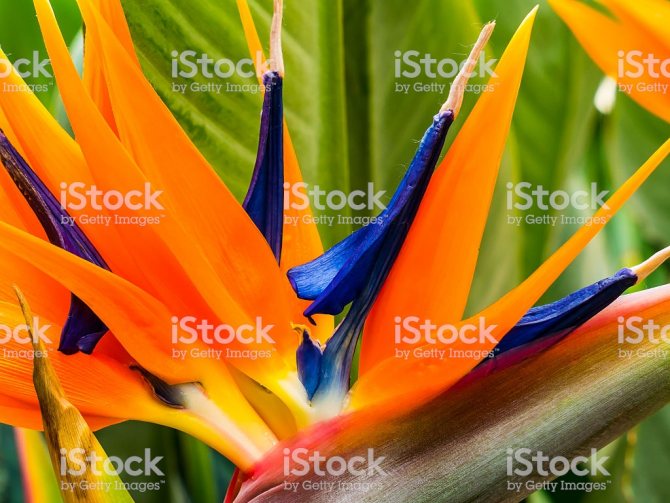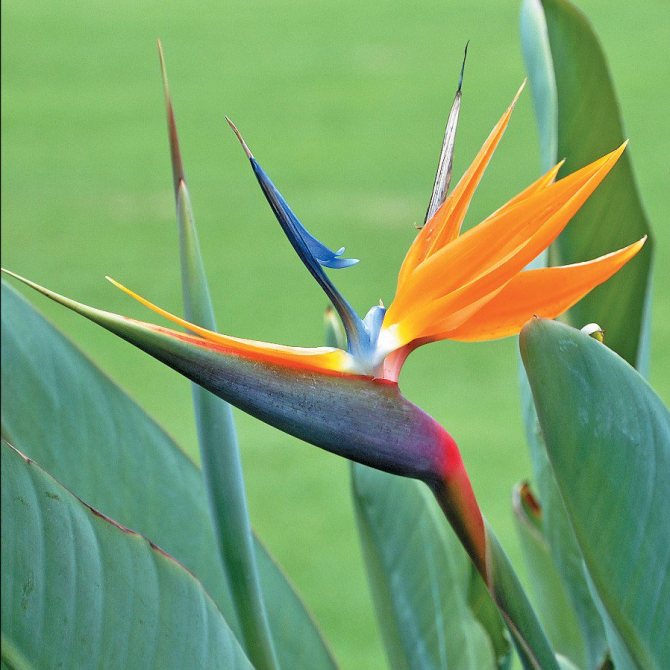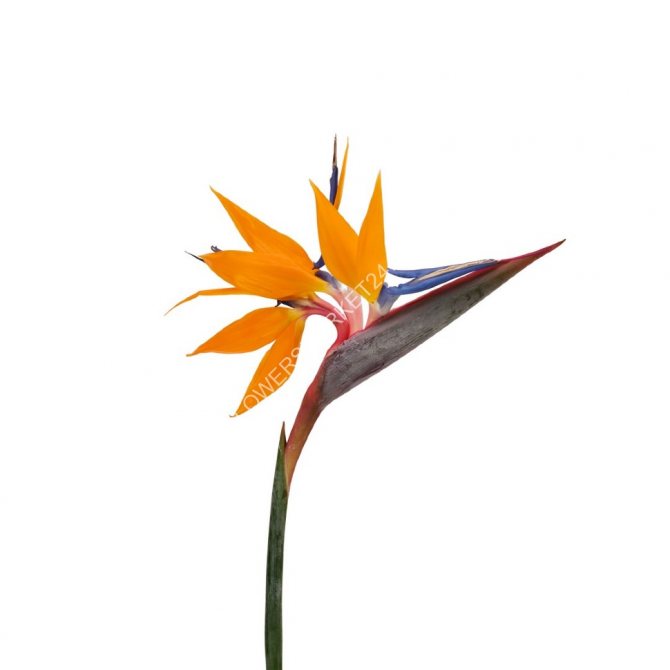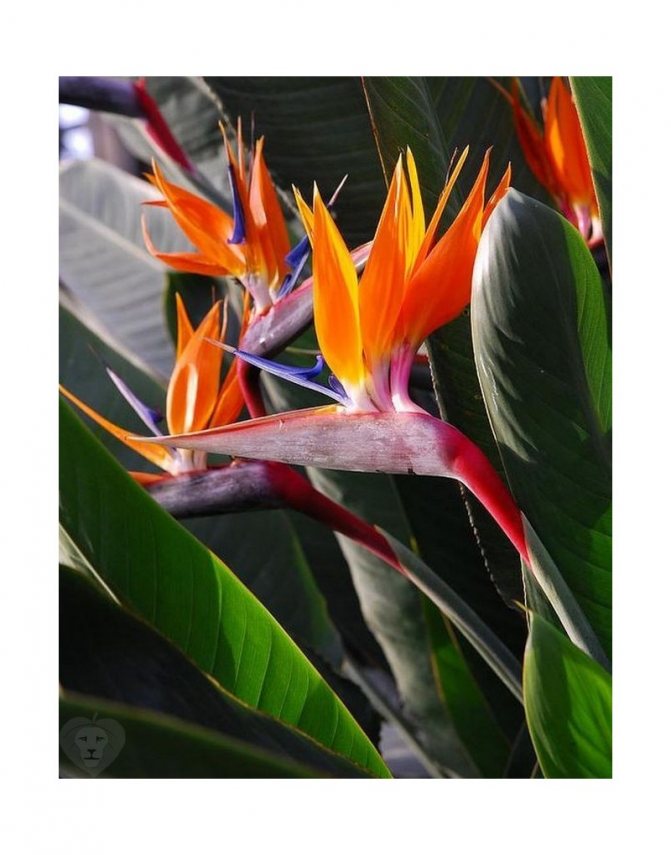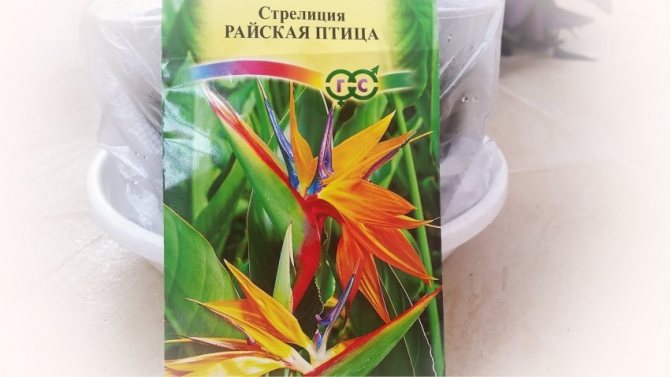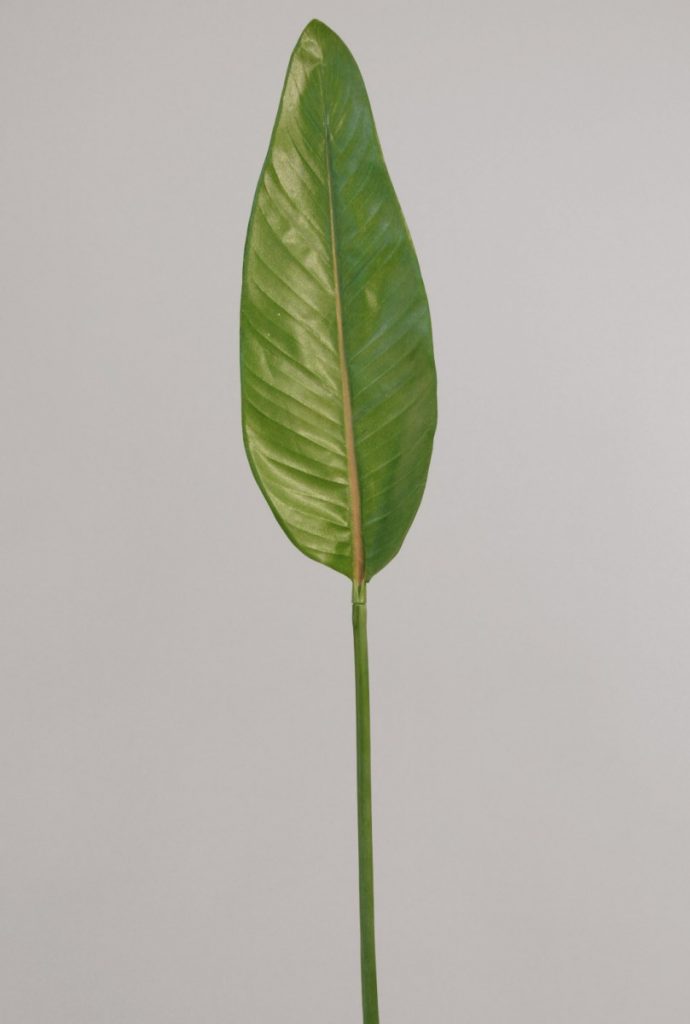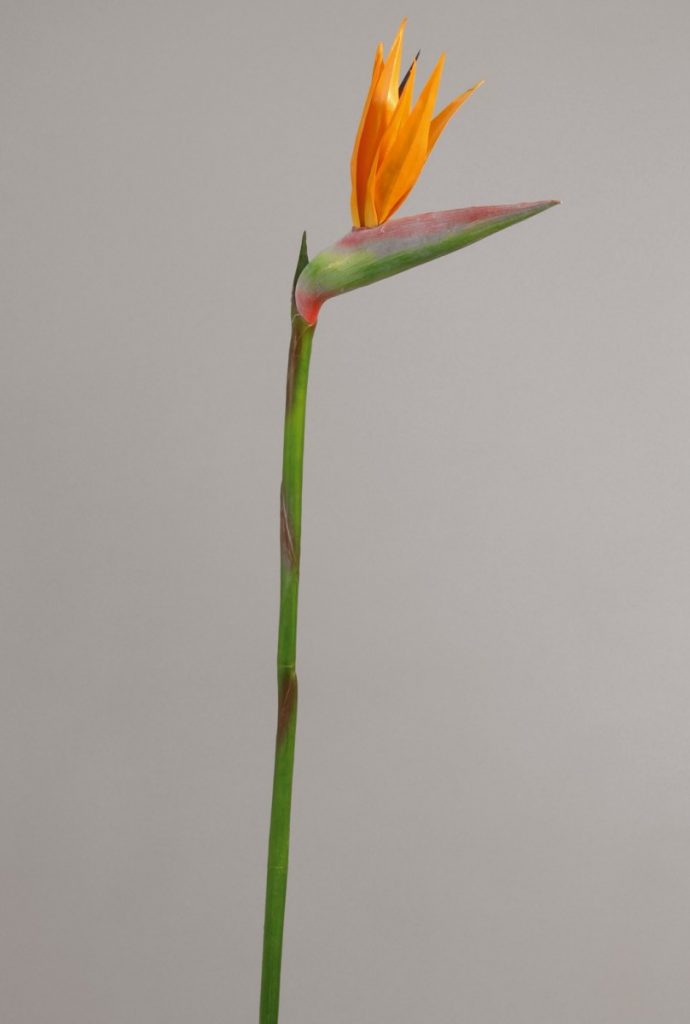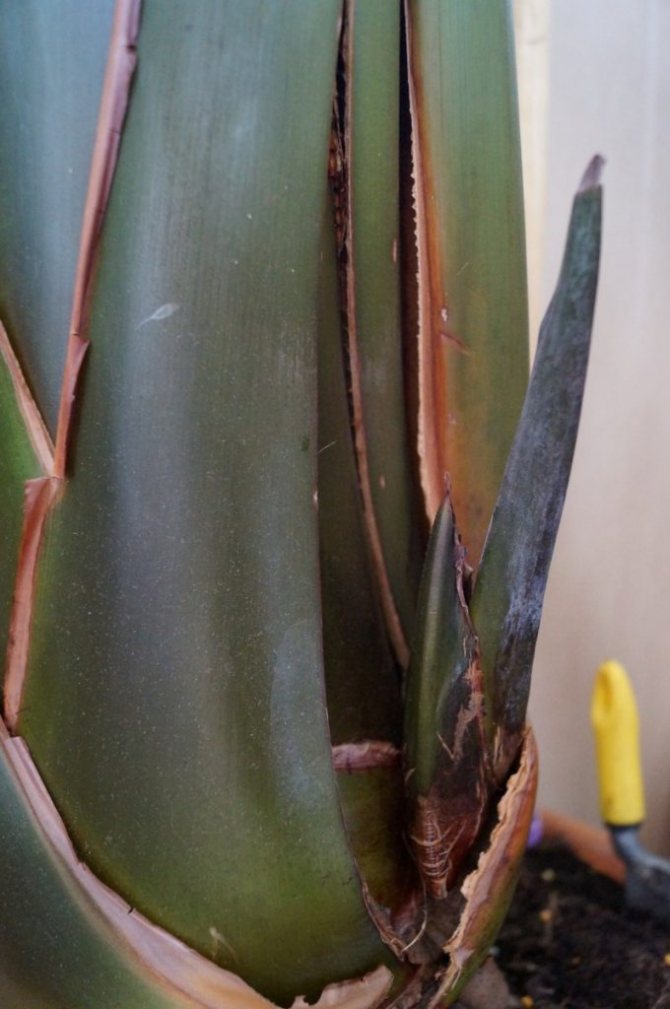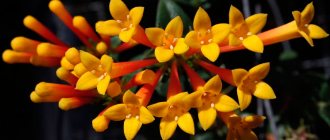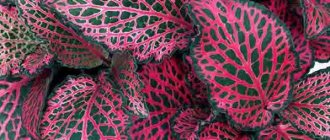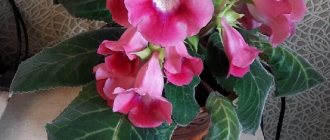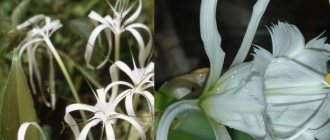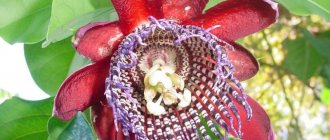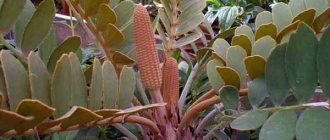
In this article, we want to introduce you to home care for the royal strelitzia - a bright and unusual indoor flower. Everyone who has seen her blooming notes that her inflorescences are surprisingly reminiscent of flying fabulous birds with bright beaks and luxurious crests. Strelitzia is a very spectacular exotic plant. But at home it is surprisingly not demanding and it grows great!
Growing rules
Next, let's talk about growing strelitzia at home.
A place
In general, the "African beauty" is not particularly whimsical, but it takes a lot of space to bloom. A small plant can be placed on a windowsill that faces east or west. But we must not forget that direct sunlight is contraindicated for her. When the plant is already large, it can be moved to the floor by transplanting it into a floor pot.
Lighting
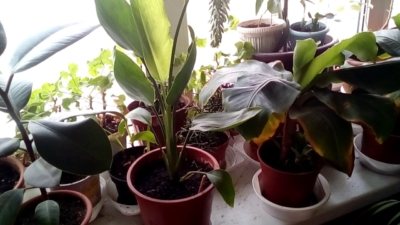

The flower is very fond of sunlight, but this does not mean that it needs to be placed under the scorching rays, as mentioned above. Strelitzia prefers intense but diffused light. The flower tolerates the rays, but in hot weather it is better to put it in the shade.
The plant should not be placed only on the north side, and the growth process is going very well on the other windows. If possible, then in the summer, it is better to take the plant out into the open air (to the street or balcony). To prevent burns from appearing on it, you need to put it in partial shade.
Temperature regime
Strelitzia loves warmth very much. But in the winter season it is better to put it where it is cool and the temperature is approximately + 15 ° C. She also likes fresh air, so in the hot summer period, the "queen" can and should be taken out onto the balcony, having previously protected it from the scorching sun and strong winds. The plant feels great in summer at a temperature of + 18-24 ° C, and in winter at + 12-16 ° C.
Air humidity
"Paradise flower" calmly tolerates dry air. But it will be grateful if you spray it periodically. Therefore, the best option would be the air humidity in the room slightly above average. It is enough to wipe the leaves from dust once a week with a damp sponge.
Watering
It is also necessary to ensure that the water in the soil does not stagnate. The resulting water in the pan is poured out immediately after watering. In winter, the plant needs to be watered once a month.
The soil
Soil for strelitzia is suitable light and nutritious with acidity up to pH 6.5... The best option is a mixture of fine sand, turf, humus, leafy earth in a ratio of 0.5: 1: 1: 1.
Top dressing and fertilizers
In spring and summer, when the flower blooms profusely and actively grows, it is fed with fertilizers that contain nitrogen. This should be done several times a month while watering. After flowering stops, fertilization is not necessary at all for 11-13 weeks.
Two or three times a year, the soil should be replenished with complex mineral fertilizers, especially for adults.
You can find out about the peculiarities of growing Royal Strelitzia at home here.
Here you can see a photo of a flower that is properly looked after at home.:
Pests of Strelitzia
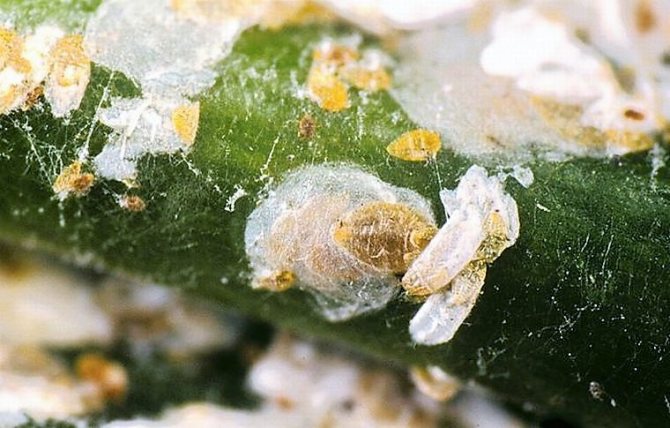

If you keep the flower clean, constantly spray it and wipe its leaves, and you have nets on your windows from random insects from the street, if you don't flood Strelitzia and make a swamp in its pallet, you have nothing to fear from intruders-parasites. And yet, we recommend that you regularly examine your beauty for damage by scabbards or other pests of indoor flowers. If found, wash all parts of the plant in the shower, remove the remaining individuals with a cotton alcohol or soap swab. For a greater guarantee, we recommend spraying Strelitzia with an insecticide, precisely from your pest - there are a great many of them on sale. Read the instructions on the package. It may be necessary to process the diseased plant several times with an interval of 5 to 10 days.
Flower transplant
Soil preparation
Young plants need to be transplanted into other containers every year, since the roots grow deeper and they need more space. This is also done in order to speed up the development process. When the “flower of paradise” grows up to 3 years old, they stop doing such a frequent transplant.
Grown individuals are transplanted every four years.... Because the root system is very fragile and can easily break and the plant can therefore become sick. In the best case, you will have to wait a long time for flowering, but the consequences can be much worse.
A slightly acidic soil, closer to neutral, is perfect for the plant. Before replanting, it is better to mix the nutrient components into the soil in advance. It should include river sand, peat and humus, always in equal parts.
Pot selection
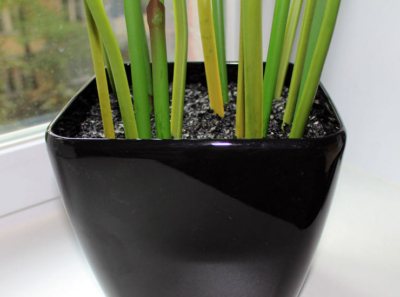

For strelitzia, tall, narrowed pots are best suited. At the bottom, you need to put a layer of expanded clay for drainage (about 5 cm), then nutrient soil, and then carefully plant the plant. If the flower has problems with the roots, then in this case the dead roots are first cut off and only after that they are transplanted.
You need to choose a pot depending on the growth of the plant.... If you want to transplant a very small plant, then the size of the product is not required so large for this. But if the individual is already an adult, then a large floor pot will be required for the plant to be comfortable in it.
Reasons for the lack of flowering
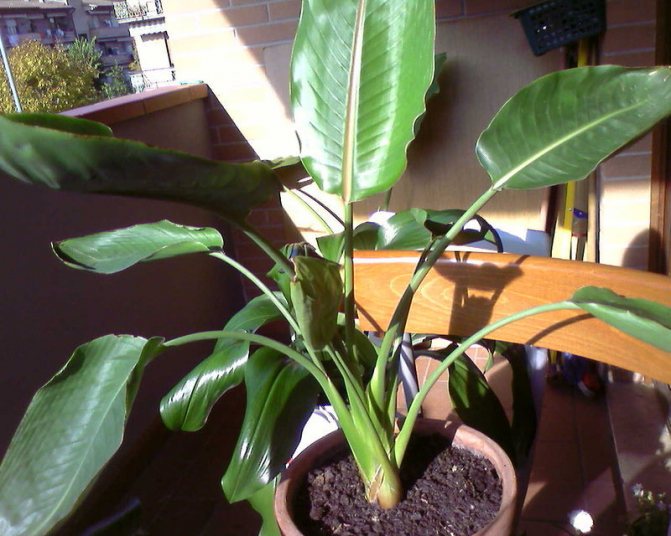

I would like to note right away that strelitzia begins to bloom only after reaching the age of four.... Of course, there are awkward situations when even an adult strelitzia does not give flowers. This requires a special approach. The flower needs to be taken out in winter for a short time to an insulated balcony, the temperature in which does not exceed ten degrees. Then the bush must be brought back and to its old place. After such a temperature drop, the flower should bloom.
Diseases and pests
Strelitzia has good immunity. But like all other plants, the "Queen" can also be defeated by pests or it can be overcome by a disease.
Pests
Strelitzia can be affected by several types of pests. These include scale insects, spider mites, and mealybugs.
- Mealybug can be removed only 2 times by treating the flower with "Aktara". After the first session, you need to wait a month and only then repeat the procedure.
- When fighting the scabbard, the same measures help.
- The mites are cleaned up with chemicals such as acaricides.
Read also: A simple recipe for jellied pie
Diseases
Leaves turn yellow
If only a few lower old leaves turn yellow, then this is the norm. But if all the foliage begins to turn yellow, then the problem lies in improper care of the plant. This means that the bases of the stems and the root system of the plant have begun to rot. This is due to too much moisture. This problem can be eliminated by reducing the watering force when removing the affected areas, you can still check the condition of the drainage.
Leaves dry
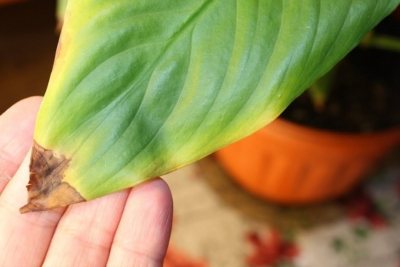

This problem is also mainly associated with waterlogging of the soil.How to solve it is written in the previous paragraph. But if everything is fine with watering, then the problem may be in the low humidity of the air, so its leaves began to dry and curl at the tips.
This problem can be eliminated by spraying the plant.... But it is important to know that if, after this procedure, you put the plant in the sun, then burns will appear on it. In winter, you can simply put a container with water or a box with wet expanded clay next to it.
Drops buds
If, during flowering, strelitzia began to lose flowers, then most likely this was influenced by the rearrangement of the plant. During the flowering period, it is better not to change the location of the flower.
Plant wilted
Strelitzia has a good immune system that can withstand various diseases. But this does not mean that she does not need care and attention at all.
Reproduction of strelitzia
Strelitzia can be propagated in two ways:
- seeds;
- dividing the bush.
When propagating strelitzia by seeds, it should be borne in mind that they lose their germination quickly. It is better to sow freshly harvested planting material. It is important to look at the markings and packaging date on purchased seeds. Before planting, they are soaked in warm water and sown in ground pre-scalded with boiling water.
The seeds must simply be pressed into the ground, without sprinkling. The boxes are covered with glass. Scattered light should fall on them, and the temperature should be at least 24 degrees. Before emergence, the glass is not removed.
The first shoots may appear in 1.5 months, but sometimes this period takes up to six months. After the emergence of shoots, the glass begins to be removed gradually, first removing it for 1.5 hours a day, and then gradually increasing the time. Root watering is best avoided by lightly sprinkling the seedlings with boiled water.
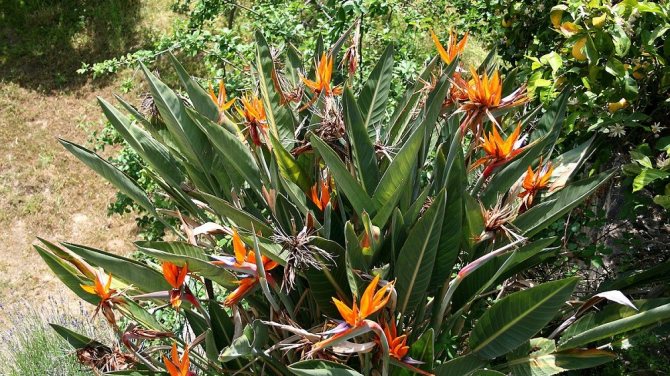

Strelitzia can be propagated by dividing the mother bush
It is allowed to divide the bush only when its age reaches 5 years. Divide strelitzia after flowering. Each seedling should have one shoot and part of the rhizome.
When and how does it bloom?
Period
If the flower should bloom for the first time, then this process begins in spring or summer at 4-5 years of age. This flower can rightfully be called one of the most unusual because of its flowers and rather large stems. His color is also fascinating: the outer leaves are colored orange, and the inner ones are dark blue.
In appearance, the flower looks like a bird that flies, therefore, the people called it "the bird of paradise". Flowers are odorless, but they have a lot of nectar... There is so much of it that drops of nectar flow out of the edges of the flower of the flower.
Before flowering, there is a process of so-called dormancy, at which time flower buds are laid. This is considered a preparatory period. The flowers themselves reach a size of 10-20 cm. It is considered the norm when there are 5-7 flowers on one peduncle. But on one plant, the number of pedicels can be more than six pieces, so it blooms almost until the dormant period.
Why isn't this happening?
There are several reasons:
- Perhaps this is due to the small amount of feeding, she likes to be fed every 10 days during preparation for flowering and growing season.
- Another reason may be an unsuitable pot, check.
What to do?


If strelitzia does not bloom for a long time, then in this case, you can try treatment by changing the temperature regime. To do this, the flower must be placed for some time in conditions where the temperature will be only 10-12 ° C, and then returned to its original place. This usually helps to stimulate the flowering process.
Do not forget to cut the flowers correctly, then they will surprise you with their vitality. If you put flowers in plain water, they will live for about 14 days.... But if they are placed in a special maintenance solution, the lifespan will increase to 30 days. Longer flowering time only in orchids.
What to do to make the strelitzia bloom is described in this useful video:
Thus, we can conclude that if you are the owner of strelitzia, then you are definitely in luck. This flower is of extraordinary beauty. We can say with absolute certainty that he will delight you and your loved ones.
If you find an error, please select a piece of text and press Ctrl + Enter.
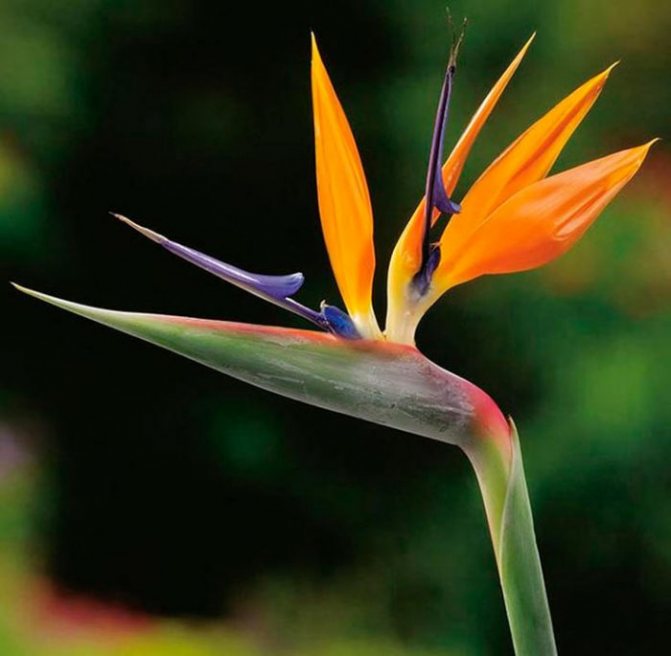

The Strelitzia plant, also called Strelitzia, is a type genus of the Strelitziaceae family. This genus unites 4 species that are found naturally in Madagascar and South Africa. This plant got its name in honor of the wife of King George III, Queen of Great Britain, Charlotte-Sophia Mecklenburg-Strelitz. At the same time, one of the species was named royal strelitzia, and the other - Nikolai's strelitzia in honor of the all-Russian autocrat Nicholas I. In the people, this plant is called "bird of paradise", this name is associated with the unusually beautiful flowers of this plant.
How to choose Strelitzia in the store
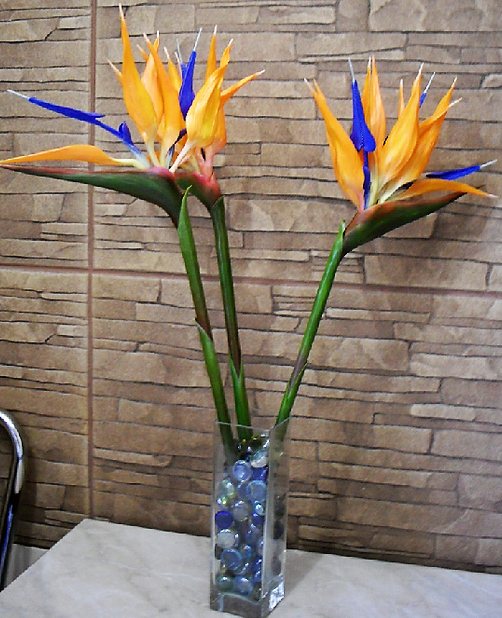

If you decide to purchase a ready-made Strelitzia bush in the store, carefully examine the plant you like. It should look healthy and strong. Its inflorescences should be slightly swollen or slightly open - a guarantee that Strelitzia will bloom at home. Pay attention to the petals of the flowers - they should be slightly visible.
If you bought cut flowers, in order to put them at home in a vase of water, we will show you what to do to make them bloom longer. It is necessary to carefully open each long green sprout-cover - it is, as it were, a bed in which a flower sleeps in the dark. It must be opened along its entire length and, thus, show the sleeping flower the way to the sun. If this is not done, the flowers will simply rot in their dark cradle. After that, place the vase with the bouquet in a well-lit place in the room and do not forget to change the colors of the water. If you do everything right, then for two or three weeks you will admire the bloom of this bird of paradise.
We introduced you to the amazing tropical beauty Strelitzia, which in ordinary indoor conditions can give you an unforgettable sight: a flock of fabulous tropical birds with feathery tails has settled on the dark green, huge, banana-like leaves of the plant and does not fly away from there for several months. Up to six months you will have a festive mood from the contemplation of this wealth of colors. And the unpretentiousness and gratitude of the flower will simply surprise you! It is not for nothing that Strelitzia has recently become increasingly popular among lovers of rare species of exotic indoor plants.
Brief description of cultivation
- Bloom... In spring, for 6 weeks.
- Illumination... A diffused but bright light is needed, so it is best to choose an east or west windowsill.
- Temperature regime... During vigorous growth, the plant does well at normal room temperature. In winter, the room should be colder than 14 degrees.
- Watering... During the growing season, water should be often, but in moderation, while the potted soil should be slightly damp all the time. In winter, watering is carried out approximately once every 1.5 weeks.
- Air humidity... It should be elevated. On hot days, spray the foliage with a spray bottle.
- Fertilizer... During the growing season and during flowering, the bush is fed regularly once every 10 days, for this, mineral fertilizers and organic matter are alternately used.
- Rest periodI. Conditional, in winter.
- Transfer... While the bush is young, it is transplanted once a year, and more mature plants - once every 3 or 4 years.
- Reproduction... Seeds (must be freshly harvested), side shoots and parts of those bushes that are already 6 or 7 years old.
- Harmful insects... Scabbards, mealybugs, aphids and spider mites.
- Diseases... This plant is highly resistant to disease. However, due to the regular waterlogging of the soil mixture in the pot, the root system can rot.
Vegetative breeding methods
There are two options for vegetative propagation of strelitzia - by dividing the root and side shoots (both procedures are convenient to perform during transplantation), but they must be at least 6 years old. We carefully separate the lateral shoots together with the rhizome without damaging it. The new plant must have at least three shoots. We plant new plants in a pot using the same technology as when transplanting strelitzia.
Important! Young transplanted plants cannot be kept under the bright summer sun, as it will simply burn the immature flower.
Strelitzia features
Under natural conditions, strelitzia is a herbaceous evergreen perennial plant. The height of the largest specimens in the wild can reach more than 10 m, and the average size of the bushes is 2–3.5 m. The core system of roots goes into the deep layers of the soil. Large oval green leaf plates, leathery to the touch, have a bluish-gray bloom on the surface. The leaves can be up to 0.1–0.8 m wide and 0.3–2 m long, outwardly they are very similar to banana foliage, but their petioles are longer - 0.5–0.9 m. the peduncle is a horizontal inflorescence, which outwardly resembles the tuft of a bizarre bird, it consists of purple or orange flowers, which reach 10–20 centimeters across. On one peduncle there can be 5-7 flowers, while on one bush 6 peduncles and even more are formed, in this regard, the plant can bloom up to 6 months.
If you take good care of your home strelitzia, it will delight you with its long, lush flowering several times a year. In the cut, the flowers of this plant stand for a relatively long time - from 15 to 30 days.
Description of the plant
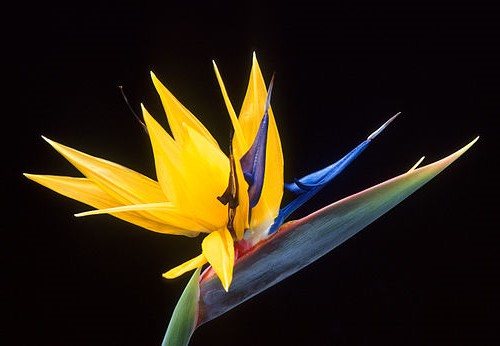

You may have already seen the flowering thickets of Strelitzia on the coasts of the Mediterranean. There it grows everywhere, and amazes the views of ordinary people and vacationers with abundant colorful flowering of luxurious flowers of various shades throughout the warm period. In the wild, they are herbaceous evergreen perennials from one and a half to three and a half meters in height. However, as already mentioned above, there are powerful specimens that grow much higher. The root system of Strelitzia is pivotal, deeply embedded in the soil. Not only the flowers of the plant are beautiful, but also its leaves. They are large, slightly leathery and wavy. The leaf shape is oval. Its color is dark green with a bluish bloom. The length of one leaf reaches 45 cm in length and 20 cm in width. Strelitzia leaves are very similar to banana leaves, only their petioles are longer, from 50 to 60 cm in length. At home, these sizes are noticeably smaller. So, the height of a houseplant is rarely higher than one - one and a half meters.
It may be interesting: Oleander - rules for caring for a poisonous flower
Strelitzia blooms also unusually. First, scaly leaves appear on long peduncles, the very last one looks like the head of an exotic bird. Then quite large flowers, from 10 to 15 cm in diameter, appear. In Royal Strelitzia flowers, the outer petals are orange, and the inner ones are dark blue. But other species have flowers of white, yellow, lilac, purple and blue hues. The flowers are arranged in a horizontal inflorescence, similar to the crest of an outlandish bird. The buds open within one to two weeks. When some fades, others appear. One specimen can have up to five or more peduncles, and each peduncle reveals from five to 7 flowers.Therefore, flowering sometimes lasts almost six months and captures both the spring and summer months. Sometimes they do not wait for the flower to fade - it is cut and sent to a vase of water. There he can stand for a long time - up to a month (subject to a bright, warm place and a regular change of water in the vase). On Strelitzia, to replace him, a new bud will immediately open.
It should be borne in mind that Strelitzia belongs to low-toxic plants. The juice of its leaves is conventionally poisonous, the flowers are not suitable for food. Therefore, it is necessary to place containers with these plants in places inaccessible to small children and pets.
Home care for strelitzia
Illumination
It is quite simple to grow strelitzia at home, since it is distinguished by its unpretentiousness and undemanding care. Since it grows best under bright diffused lighting, it is recommended to put it on the west or east window. Do not expose the bush to direct sunlight.
Temperature regime
This plant is thermophilic, however, during the dormant period in winter, it should be kept cool (no higher than 14 degrees). At other times of the year, it grows well and develops at a temperature typical for residential premises. In the warm season, if possible, it is recommended to move the strelitzia to the street (to the garden or to the balcony), but you should choose a place for it that will be reliably protected from gusts of wind and direct sunlight.
Watering
During the spring and summer period, watering should be moderate but frequent. Make sure that the earthen mixture in the container is slightly moistened at all times. But do not overdo it with watering, as the systematic stagnation of fluid in the root system can harm the plant. In winter, watering is carried out approximately once every 10 days. For irrigation, you should use filtered or well-settled water, the temperature of which is close to room temperature.
Air humidity
In indoor conditions, such a plant needs a slightly increased air humidity. In this regard, on hot days, leaf plates must be wiped off with a damp sponge or sprayed from a spray bottle.
Top dressing
Home strelitzia is fed during flowering and during the growing season once every 1.5 weeks. For this, both mineral fertilizers and organic matter are used, and they should be applied to the substrate one by one. After the end of flowering, the plant is not fed for 2-3 months, while a dormant period is observed. Before moving the bush to a cool room, where it can have a good rest, all flower stalks are cut off from it.
Read also: Damp the wall in the apartment what to do
Strelitzia transplant
If young bushes are transplanted regularly once a year in springtime, this will have a positive effect on their development. Adult bushes are subjected to this procedure only once every 3 or 4 years, because their roots are very fragile and can easily break during transplantation.
However, some growers have learned to replant Strelitzia in such a way that its root system is not stressed. To do this, first prepare a special loose and nutritious soil mixture: combine sand, peat, humus, leaf and sod soil (taken in equal parts). The container for planting is taken high and a thick drainage layer is made at its bottom, it is sprinkled with a layer of the prepared substrate. Then carefully transfer the healthy bush into a new pot and slowly fill all the voids with fresh earth mixture, which is regularly compacted. If the bush has root problems, then first take it out of the old pot and carefully remove all the old substrate. After that, carefully inspect the root system and cut out any diseased areas, and then sprinkle the cuts with charcoal powder. Next, the bush is planted in a new container.
Diseases and pests
Mealybugs, spider mites and scale insects can settle on the plant. To get rid of scale insects and mealybugs, the bush is sprayed with Aktara's solution, re-treatment with the same agent is carried out after 20 days. To combat ticks, acaricidal preparations are used.
Strelitzia is highly resistant to disease, but only if you take proper care of it and provide it with optimal conditions for growth.
Why does strelitzia not bloom
Only a plant that is at least 4–5 years old can bloom. However, it may happen that the strelitzia is already old enough, but there are still no flowers on it. To fix this, temperature stress is arranged for the flower. To do this, the bush in winter or early spring is transferred for a short time to a loggia, an insulated balcony or to an unheated veranda, while the air temperature there should be from 10 to 12 degrees. Then the bush is returned to its permanent place, which should be well lit. Next, take care of it as usual and wait for it to bloom.
Diseases
Indoor strelitzia, subject to normal growing conditions, rarely gets sick. However, any violations of water or temperature regimes can provoke diseases of the roots or leaves of the plant. Consider the possible problems of growing a Bird of Paradise.
- If dark spots appear on the leaves of strelitzia, the reason lies in an excess of moisture in the root system. Check if there is a sufficient drainage layer in the pot, if excess moisture is stagnating in the pan, think if you water your pet often. Correct the situation. Cut off the affected leaves. If the roots begin to rot, the flower should be removed from the pot, the affected parts of the roots should be removed, the sections should be treated with crushed charcoal or activated carbon. Strelitzia will have to be transplanted into a different soil and not allow previous mistakes.
- If the edges of the leaves and their tips turn brown, then the air in the room is too dry. It is necessary to spray the plant regularly. In addition, place the flower pot in a tray of damp expanded clay, turn on air humidifiers, if you have them.
- If, during flowering, Strelitzia suddenly began to shed its buds, the reason may lie in moving the plant from place to place or turning the pot in different directions to the sun. Royal Strelitzia doesn't like to be disturbed during flowering!
- If Strelitzia's leaves begin to wither and turn yellow, the plant may be cold. If this happens during the winter months, and the pot is intentionally placed in a cool room, we still recommend moving it to a room with a higher temperature. The lower temperature threshold for Strelitzia is 12 degrees.
- If the leaves of the flower began to spontaneously crack at the tips and break, then the plant lives in stress from temperature changes or irregular watering. Draw conclusions. Correct the situation.
What to do if strelitzia does not bloom
There may be several reasons why Strelitzia does not bloom at home:
- Perhaps you feed her little, but she loves to be fed every 10 days with organic matter or mineral fertilizers during active vegetation and preparation for flowering. You can use complex fertilizers for flowering indoor flowers.
- Also check if the flower pot is suitable. If it is too large, then flowering will not occur until the root system of the flower has completely mastered the soil space. And if the pot is too tight, the roots rest against the walls and come out of the drainage holes, you will have to transplant the plant into a suitable container and wait for flowering for another year.
- Remember if Strelitzia had a dormant period last winter or fall, during which she would rest and gain strength for flowering. The conditions must be appropriate: cool room, moderate watering, lack of fertilizing.If this was not the case, then you will have to provide her with these conditions this winter, then Strelitzia will definitely bloom next year.
Reproduction methods
Growing from seeds
Strelitzia seeds after harvesting very quickly lose their germination. For reproduction, it is recommended to use freshly harvested seeds, but in order to get them, you will have to resort to artificial pollination of the plant. If you decide to grow strelitzia from purchased seeds, then pay special attention to the labeling on the package. At the same time, remember that from seeds that have already turned 6 months old, only one seed out of ten remains viable. Purchased seeds are sown immediately at any time of the year, but they are subject to mandatory pre-sowing preparation. To do this, place the seed for 24 hours in warm water (from 35-40 degrees), as it cools, change the water to fresh. After the seeds are well swollen, the remnants of the fruit, if any, are removed from them.
For sowing, prepare a special soil mixture, which should consist of compost, peat and river sand (1: 1: 1). Plastic cups with a volume of 0.25 liters are filled with it by 2/3, and several holes are made in their bottom, reaching 0.5 cm in diameter.Pour the substrate well with freshly boiled water and tamp it. After it cools down, its surface is covered with a layer of sand about 20 mm thick, then one seed is placed in each glass and pressed with a finger so that only its back is visible. Crops are transferred to a warm (from 22 to 24 degrees) and well-lit place, protected from direct sunlight. Do not forget to cover the cups with foil, after which they are left alone until the first sheet plate appears on the surface of the substrate. As a rule, it takes a long time to wait for the emergence of seedlings (from 1.5 to 6 months), all this time do not remove the shelter from the container. When the first leaf plate appears at the seedlings, they begin to ventilate, removing the shelter for only 15–20 minutes. per day. When the seedlings appear, they will need to be watered after the top layer of the substrate has dried; for this, boiled water is used. When the plants grow up and get stronger, they are carefully transplanted into larger pots. During transplantation, it should be borne in mind that the long tap roots of this plant are very fragile and thick, if damaged, this can lead to a delay in the growth of the bush or to its death. While the bushes are young, they are moderately watered and grown in a well-lit place and at a temperature of about 22 degrees.
Reproduction by dividing the bush and side shoots
If the bush has reached the age of 6-7 years, then it can be propagated by dividing the bush, and often lateral shoots are used for reproduction. The most successful delenki take root after the end of the flowering of the plant. The bush is pulled out of the container and divided into parts, and each cut must have at least one shoot. Part of a bush or a side shoot is planted in a pot, reaching 16–20 centimeters across (the size of the container depends on the size of the cut or shoot). The planting substrate is used the same as for growing seedlings (see above). Try not to injure the roots during the transplanting of the divots.
Reproduction
You can propagate Strelitzia using seeds, dividing the bush into parts and separating the side shoots from the mother bush. Let's consider all the ways:
Seed propagation
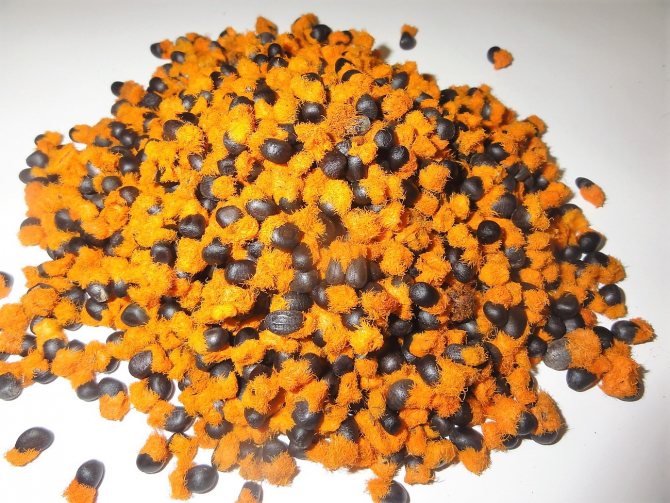

Growing strelitzia from seed is most preferred. Under natural conditions, Strelitzia seeds are formed after pollination of flowering plants with a tiny bird from the sunflower family. The growth of the pollinating sunbird is less than 3 cm. The sweet nectar of Strelitzia attracts birds and pollinating insects to flowering plants.As soon as a sunbird or other bird sits on a flower and tries to get to the nectar, pollen from the stamens shoots around, settles on the breasts and legs of pollinators, which then transfer it from one flower to another. At home, you will play the role of a pollinator. To get your seeds, you must have some flowering Strelitzia bushes. If so, you can gently transfer pollen from the stamens of one flower to the stamens of another with a clean brush. We recommend pollination several times within a week after the opening of the bud. If pollination is successful, the fruit (woody tough capsule) will ripen after six months. Freshly harvested Strelitzia seeds, peeled from the pulp, should first be rubbed gently with sandpaper, then soaked for a day in hot (40 g) settled water, it is possible with the addition of Epin or Zircon stimulants. Then the seeds are planted in a container with a wet mixture of peat and sand under the lid, to a depth of half a centimeter. Seeds germinate within one to two months (sometimes longer) in a bright place at a temperature of 22-24 grams. The greenhouse is ventilated and watered abundantly. When the sprouts are ready for transplantation, that is, the first leaves appear, they are transplanted into separate pots of suitable size according to all the rules of transplantation with nutrient soil and drainage and placed in a cooler place. Do not forget that the roots are very fragile and easily damaged. Therefore, transplant very carefully. Damaged roots during childhood can affect the entire subsequent life of a flower. If everything went well, an adult plant grown from seeds will bloom in three to four years, or even more. How lucky you are! The longest flowering is observed in Strelitzia at the age of 8 years. And the total period of its flowering is 10 years or more.
Reproduction by dividing the bush
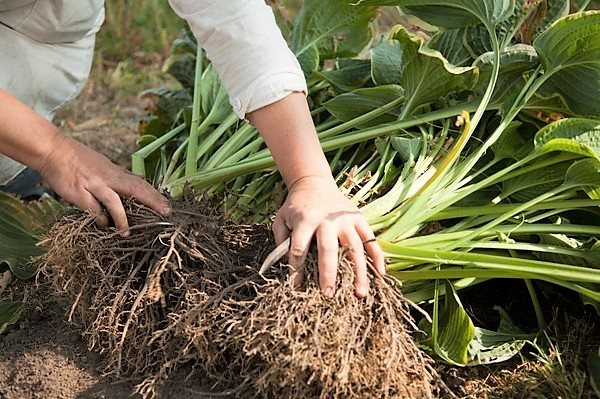

It is performed less often, since there is a danger of ruining the entire bush. And only after the end of flowering of the plant. This time falls at the end of winter and coincides with the moment of transplanting plants into new containers. The root system of Strelitzia, although powerful, is quite fragile, the roots are strongly intertwined. After roughly dividing the bush into parts, the plant can get sick and even die. If you managed to neatly divide the Strelitzia root system into parts, try to ensure that each part has two growth points. Otherwise, the transplanted bushes will grow poorly, adapt for a long time, their flowering will be postponed indefinitely. With a successful division of the bush into parts, new bushes will grow for at least a couple of years before they become adults, powerful and ready to bloom.
Reproduction by side shoots
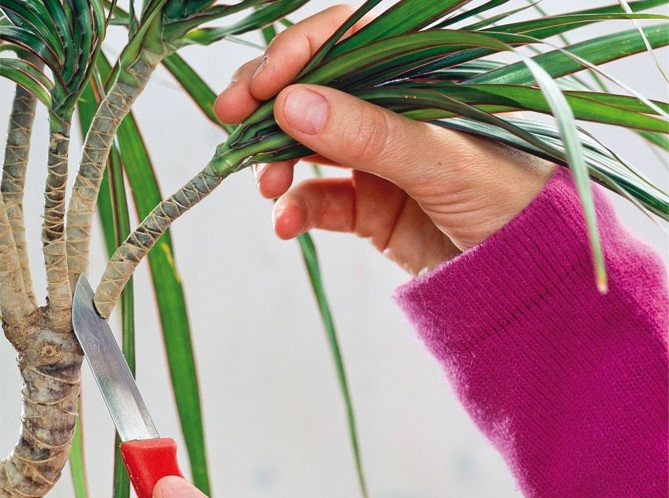

Young, still not flowering bushes of Strelitzia can be divided without problem if the bush itself has formed a lateral shoot. It is transplanted together with the roots into a new pot, and the mother plant is left in the same container. Sometimes, on the contrary, too overgrown side shoots are used for reproduction. They are carefully separated from the mother bush, if possible, together with the root, and planted in their own pots with drainage and nutrient soil under a film. The rooting process will be successful if the pot is placed on a light windowsill and the temperature is maintained within 22 - 26 grams.
It may be interesting: Camellia in the apartment - growing and care
Types of strelitzia with photos and names
Royal Strelitzia (Strelitzia reginae)
Or small-leaved strelitzia (Strelitzia parvifolia). This type is most popular with flower growers. Such a plant in natural conditions is found in the mountain forests of the Cape province of South Africa. The bush can reach a height of about 200 cm. Lush rosettes consist of large leathery dark green leaf plates, up to 0.45 m long, with a wavy edge. The petioles of the foliage are very long - up to 0.9 m. The axillary long peduncle has a green veil with red veins.The inner petals of the flower are dark blue, and the outer ones are orange, and they are about 15 centimeters long. The bush blooms twice a year.
Strelitzia nicolai
This species can be found in nature in the Cape Province, it prefers to grow in gorges, tropical forests and mountains at an altitude of about 300 meters above sea level. Outwardly, such a strelitzia is very similar to a banana, in this regard, it is also called "Natal's wild banana." This species is arboreal, since it can reach a height of 10 m. The "trunk" of such a plant is similar to a palm tree, since its surface is covered with scars left by dead foliage. During flowering, an axillary peduncle appears with four greenish-red beak-shaped veils, the outer petals of the flower are white, and the inner ones are blue, they reach about 17 centimeters in length.
Mountain strelitzia (Strelitzia caudata)
In the wild, the species is found in the southernmost point of Africa. The locals call such a rather rare plant "the banana of the desert". The height of such a tree-like plant can reach 10 m, it is decorated with very large leaf plates that grow in two rows and clasp the lower part of the trunk. White large flowers have pointed bracts of a red hue, they are similar in shape to boats, and reach about 0.45 m in length.
Strelitzia reed (Strelitzia juncea)
In nature, the species is found in the eastern part of South Africa. It is resistant to prolonged droughts and sudden temperature changes (down to sub-zero). The flowers of this species are outwardly very similar to the flowers of the royal strelitzia, but its foliage is narrow needle-like, and it grows in a dense rosette, which reaches up to 2 m in diameter.
Strelitzia Augustus, or white strelitzia (Strelitzia alba)
The homeland of such a plant is the Cape province of South Africa. In this perennial, the lower part lignifies over time. Glossy long (about 100 cm) leaf plates have an elliptical shape and a pale green color, they are heart-shaped at the base. Axillary peduncles have two lanceolate bracts with a single purple veil. The flowers are white.
Also, flower growers grow a hybrid of white strelitzia and royal strelitzia.
Botanical description and history of discovery
Strelitzia or strelitzia (Latin Strelitzia) is a perennial evergreen herb of the Strelitzivye family. These are plants of the South African continent, they were discovered and introduced to Europe in the 18th century by the Scottish naturalist Francis Masson. The indigenous people of South Africa call the plant the crane.
To say that the appearance of a plant is impressive is to say nothing. The inflorescences are compared with birds of paradise, and the name is given in honor of the Queen of Great Britain herself (Charlotte of Mecklenburg-Strelitzkaya).
The height of the largest representative of the genus is 10 m, others grow on average up to 2-3.5 meters. The leaf plates are similar to banana ones, but with a longer petiole (about half a meter). The leaves are oblong with pointed tops, 30 cm to 2 m long, and 10-80 cm wide.
When strelitzia blooms
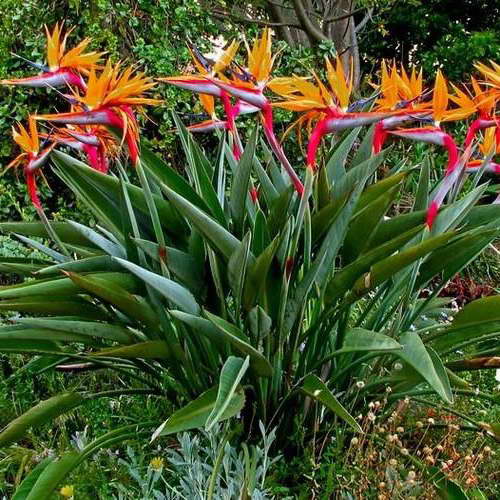

Bird of paradise strelitzia photo
The flowering period is in the winter and spring months.
Inflorescences deserve special attention. They are located at the top of an erect peduncle. First, a shell appears (in botany it is called "spathe" - translated as "wrapper") about 50 cm long, it is located horizontally relative to the soil and looks like a bird's beak. After a while, flowers appear from the wrapper, like the tuft of birds. The petals are snow-white or bright: yellow, pink. The petals join together in an arrow-shaped shape to form a nectary. Pollinating birds sit on the flower, the petals open, showering them with pollen.
The paradise flower in our latitudes is grown in indoor conditions, the plant is able to "live" indoors for 10-15 years.
Varietal and species diversity
The genus Strelitzia includes several different varieties., but six types are especially popular among amateur flower growers in our country. All these species are highly decorative, and, despite their tropical origin, they can easily tolerate indoor growing conditions, and with proper care they show bright and abundant flowering.
| Russian name of the species | Latin name of the species | Description of shoots | Leaf description | Description of flowers |
| White strelitzia | Strelitzia alba | Erect tall single shoot | Very large, banana-shaped, glossy, green, up to a meter long | Whitish in color, no more than 7.0-7.5 cm in length |
| Tailed strelitzia | Strelitzia caudata | Erect type, high, single-located shoot | Banana-shaped, green, shiny, fan-shaped, up to a meter long | Typical for the species, white and pink coloration |
| Reed-leaf strelitzia | Strelitzia juncifolia | Erect shrub aboveground part up to one and a half meters high | Elongated, reed-like, green in color | Original, orange-grayish-purple coloration |
| Strelitzia Nicholas | Strelitzia nicolai | Blooming upright, well-developed shoot | Large size, grayish color | Bluish or white coloration |
| Small-leaved strelitzia | Strelitzia parvifolia | Not too tall, up to a meter in height, erect, blooming | Long and rather tight, grayish-green in color, thin-lobed | Bluish and orange coloration |
| Royal strelitzia | Strelitzia reginae | Erect flowering shoot up to one and a half meters high | Grayish color, cannular | Purple and bright orange coloration |
Problems of indoor decorative culture
Subject to the cultivation technology, strelitzia is extremely rarely affected by pathogenic microflora or damaged by plant parasites. However, novice amateur flower growers may encounter the following problems in the process of indoor cultivation of Strelitzia:
- indoor culture is sometimes damaged by mealybugs, spider mites or scale insects, for the control of which it is best to use a two-time treatment with "Aktara" and acaricides with a three-week break;
- the absence of flowering in plants over five years old may require providing the indoor flower with temperature stress at 12 ° C;
- an equally common problem is yellowing of foliage, which is most often caused by improper irrigation measures or root rot;
- Another reason for the yellowing of Strelitzia foliage can be low temperature conditions or lack of sufficient lighting;
- leaf tips most often dry out due to insufficient moisture in the soil and at low levels of air humidity.
How to propagate strelitzia correctly
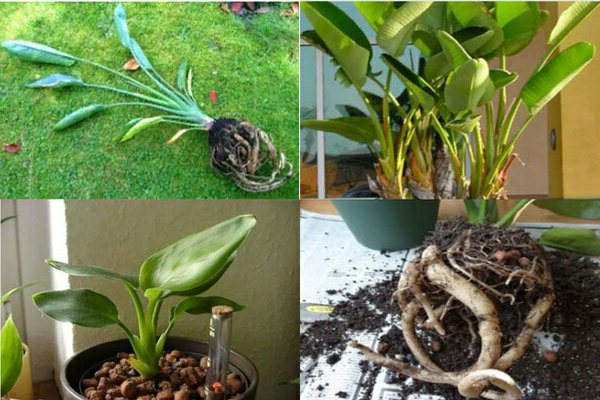

If you decide to breed strelitzia seminal method, it is important to know the fact that the freshest seeds are used for this. To obtain strelitzia seeds, it is necessary to organize artificial pollination of plants.
If you purchased strelitzia seeds in a store, then carefully study the expiration date of the planting material. There is a very small chance that the seeds are older than six months will sprout at all. The seeds that have been purchased can be sown even in summer, even in winter. The time of year is not that important in this case.
Moreover, they need to be prepared for this process. To this end, you need to immerse the seeds in water for a day, the temperature of which will vary from thirty-five to forty degrees. When the water gets colder than the specified temperature, you need to change the water to a new one. After this procedure, the seeds should be saturated with water and increase in size.
Seeds are sown in special soil, which should include river sand, peat and compost. All components are added in equal amounts. More than half of small plastic cups are poured with such a mixture.
The bottom of the same containers should have holes that are designed to drain excess liquid. Next, thoroughly pour boiled water over the soil and lightly press down on it. When the soil has cooled from watering with boiling water, you need to pour a twenty-millimeter layer of sand on top.
After that, the seeds are laid out. One glass contains one seed. You just need to put the seed on the surface, and then press it in so that a small part of it is visible above the surface.
Crops should be kept in a warm room, where the air temperature will vary from twenty-two to twenty-four degrees. This room should also be well lit.
After sowing, cover the containers with foil without fail. In such a mini-greenhouse, you need to leave crops until the first leaf appears. Seeds do not sprout quickly, it can take from one and a half to six months. It is not recommended to clean the shelter during this period.
When the first real leaf is formed, you need to start airing your seedlings every day. To do this, you need to shoot the film for fifteen to twenty minutes a day.
When the sprouts have already appeared, you need to start watering young plants. This is done after the top layer of the soil has become dry. It is best to use boiled water for watering. When the strelitzia becomes a little stronger and grows up, it can be moved to a larger container.
When replanting plants, remember that the strelitzia root system is rod-shaped. Its rhizome is very fragile. If you damage this part of the plant, then there is a risk that the strelitzia will grow too slowly or die completely.
When the plant is still at a young age, it must be kept in a bright room. The air temperature should be about +22 degrees. Watering should be moderate but sufficient.
When your bush is six to seven years old, you might think about division plants. Thus, Strelitzia is also very successfully able to reproduce. In addition, side shoots can be used for this purpose.
The separated parts of the plant are best rooted after the mother strelitzia has finished blooming. To propagate a bush in this way, you need to get the plant out of the pot and then divide it into parts.
Each of them must contain at least one shoot. Which pot to plant the cut depends on its size. Typically, the transverse size of the capacity varies from sixteen to twenty centimeters. In this case, the soil is used the same as when sowing seeds. Transplant parts of an adult plant carefully so as not to damage fragile and delicate roots.
Bird of Paradise Habits: Growing and Care
For the bird of paradise to feel good in captivity, it needs to create favorable conditions, reminiscent of the natural habitat. Wild strelitzia does not grow in dense jungle, but in woodland. Therefore, it needs space and bright light, and it will develop better not in cramped conditions among other plants, but in splendid isolation at the western or eastern window.
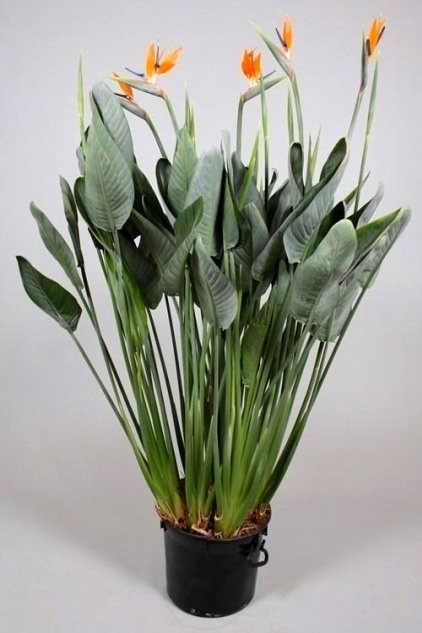

Strelitzia feels better alone, she does not like cramped conditions
The subtropical African climate is characterized by seasonal temperature drops, which means that the bird-flower will like the cold winter. But high humidity is required only in the summer heat.
Conditions of detention (table)
| Season | Lighting | Humidity | Temperature |
| Spring | Bright but diffused light, some direct sun will be helpful. Any side, except the north, is suitable for placing the arrow. With a lack of light, it does not bloom. | High, about 70%.
| Moderate, + 20-22 0С and above. Strelitzia welcomes fresh air, ventilate the room more often. |
| Summer | On a very hot afternoon, strelitzia, especially a young plant, be sure to shade. | Moderate and high, the rise in temperature will not harm if there is sufficient watering and air humidity. For the summer, place the pot with strelitzia on the balcony or take it out into the garden. But take care of strong wind protection to preserve the leaves. Fresh air helps the plant to bloom. | |
| Fall | With a short daylight hours (less than 12 hours), strelitzia will not form flower buds. If there is not enough light, add artificial lighting. | Moderate, 50-60%. It is enough to wipe the leaves with a damp cloth. Do not place the plant near heating appliances. | Moderate, + 20-22 0С. If you want to bloom for the new year, reduce the temperature dramatically. |
| Winter | The temperature is low, + 12–160C. Less than +10 0С strelitzia will not be pleasant. At high temperatures in winter, there will be no spring flowering. It is necessary to protect from cold drafts, but ventilation is good for the plant. |
About florarium
The florarium, in which plants that are difficult to grow, are planted, not for strelitzia. The bird of paradise is freedom-loving and will not be able to get along with other representatives of the flora in a glass cage. She prefers single placement. And it will be difficult to choose an "aviary" for a large flower.


Strelitzia is a big individualist, she will not be able to live in the cramped florarium
In addition, Strelitzia is not afraid of changes, but welcomes them. It responds well to temperature changes and changes in air humidity. Such a shake will be beneficial for the plant and make it release flower stalks.
Clean leaves are a healthy plant
While strelitzia has not bloomed, its main decoration is large leaves. Not only beauty depends on their purity, but also the health of the plant. Therefore, regular wet cleaning is very important. Take a soft cloth at least once a week, moisten it and wipe the strelitzia foliage.
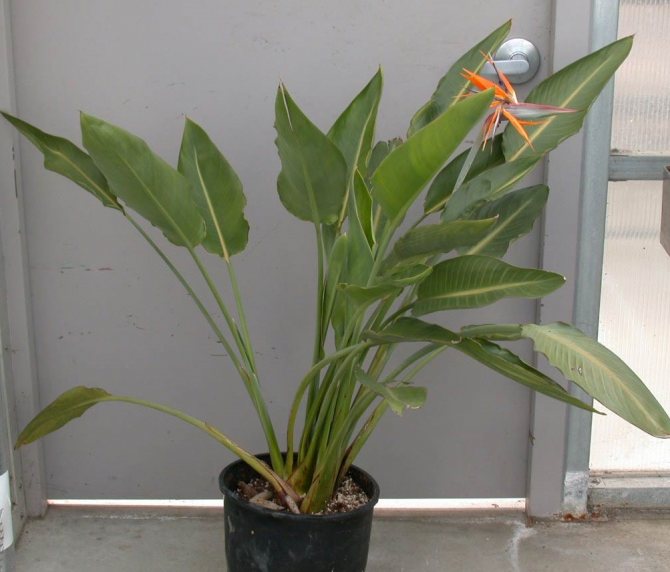

For health and beauty, often wipe the large leaves of strelitzia
To speed up and facilitate harvesting, pre-spray the plant. Clean up in the morning so that the foliage is completely dry by night.
Video: strelitzia in the greenhouse
Some problems in the growing process
Why does strelitzia not bloom, when it seems that everything that could be done at home has been done? How to "make" it bloom? Usually the first time she blooms for 4-5 years of her life, but it often happens that the "queen" never grows overgrown with flowers. Discarding diseases and pests, we list several possible reasons:
- During the last transplant, the integrity of the root system was violated. In this case, you have to wait a bit.
- Supersaturation with nitrogen fertilizers. In this case, the vegetative part develops abundantly, but flowering is delayed. To stop this, you need to reduce the amount of nitrogen-containing fertilizer applied to a minimum. In addition, apply drugs such as: "Blossom" or "Ovary".
- Lack of light. Everything is clear here, you need to move the flower closer "to the sun" but without prolonged exposure to direct rays, to avoid burns. The best is bright, diffused light.
The plant feels great at an air temperature of + 18-24 ° C in summer, + 12-16 ° C in winter. Sometimes, in order for strelitzia to bloom, it is required to forcibly transfer the plant to dormancy - take it to a balcony or loggia in autumn or spring, and hold it there at an air temperature of + 12-15 ° C (for a month), while watering is reduced to a minimum, like in winter. Just don't freeze the roots. At prolonged air temperatures below +10 ° C, they begin to die off. You can also arrange temperature stress in May: during the day - at home, at night - on the loggia.
“Why does Strelitzia roll the leaves?” Is also a fairly common question and there are several answers to it:
- Your home "queen" is simply hot. Comfortable growth and flowering conditions 18 ° C. Up to +24 ° C, Strelitzia feels good, but with a further increase in temperature, it begins to "suffer".
- Improper watering or stagnant water in the soil. Transplant the bush into a larger pot, check the roots (do not rot), do not spare the expanded clay on the bottom and add coarse river sand and the smallest mild pebbles to the soil. Stop feeding.
- Wipe the leaves with warm water from time to time.
In general, strelitzia is not a capricious plant that will delight you for 10-15 years with its luxurious flowering. Its flowers are good for cutting and can stand in water for up to a month. She is beautiful in bouquet arrangements. Present such a bouquet to your friends and look into their eyes when they see, among other flowers, the "head" of a bird of paradise!
Photo
Here you can see a photo of a flower that is properly looked after at home.:
Photo gallery
Temperature conditions
The best temperature for a plant will be 20-25 degrees. In winter, you need to lower the temperature to fifteen degrees. This is to create a preparation period during which the plant prepares for the flowering period.
Why do strelitzia leaves curl
There are several reasons for this phenomenon:
- The plant is hot. Overheating is no less harmful than hypothermia. Strelitzia begins to suffer if the air temperature is kept above 25 ° C for a long time. Spray the plant periodically and wipe the leaves.
- Rotting of the root system. From stagnation of moisture in the soil, the root system begins to rot, the process occurs under the soil, and the rolling of leaves is an "external signal". How to carry out an emergency transplant is described in detail above. To improve friability, small round pebbles can be added to the substrate, also adjust the irrigation system.
1. Seven Secrets of Success:
| 1. Growing temperature: spring and summer - the usual room temperature is in the range from 18 to 24 ° С, winter - a cool period of rest at a temperature of 10 - 13 ° С. |
| 2. Lighting: the flower loves bright sunlight - shade strelitzia only during the hottest daytime hours. Allow the flower to sunbathe in the morning and evening, daily. |
| 3. Watering and humidity: abundant, but rather rare watering during the period of active growth and almost dry soil in winter, tolerates dry air. |
| 4. Growing features: Strelitzia is unpretentious and forgive many mistakes in care - the flower can be recommended for novice florists. |
| 5. Priming: nutritious, with excellent drainage, easily permeates moisture and air to the roots of the plant. |
| 6. Top dressing: Strelitzia is fed with organic matter or mineral fertilizers during the growing season, 2 times a month. |
| 7. Reproduction: by division during transplantation, less often by seeds. |
Botanical name: Strelitzia.
Strelitzia flower - family... Strelitziaceae.
Origin... South Africa


What does it look like... Strelitzia are perennial evergreen herbaceous plants that form large bumps of basal leaves.
Leaves dark green, paddle-shaped, rigid, 30-45 cm long, on long, cylindrical petioles.
During the flowering period, plants form tall, strong peduncles.
Flowers showy, red or orange with purple, reminiscent of the heads of exotic birds with protruding feathers. Individual flowers remain open for a week, but they replace each other and flowering can last for several months. Flowers have no aroma.
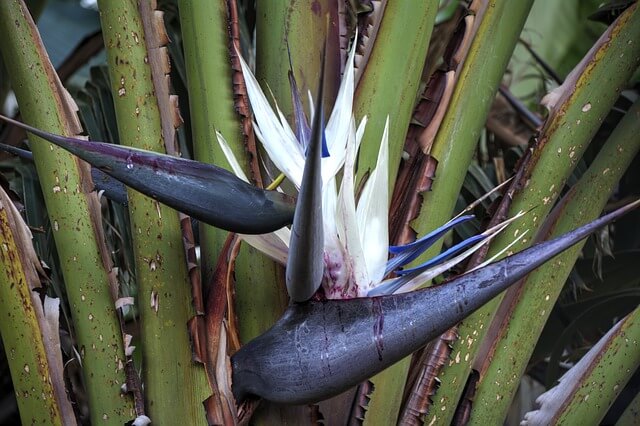

After flowering, the bushes form seed pods with rounded peas - seeds. When ripe, the seed pods dry out, turn brown and crack.
Each pea seed is surrounded by a bright orange fluffy base. When the pods crack, this base attracts the attention of birds - they peck up the seeds and carry them over considerable distances.
The second name of the plant is "bird of paradise"Given for the similarity of flowers to birds.
With age, plants can form low false stemformed by tight-fitting leaf stalks.
↑ Up,
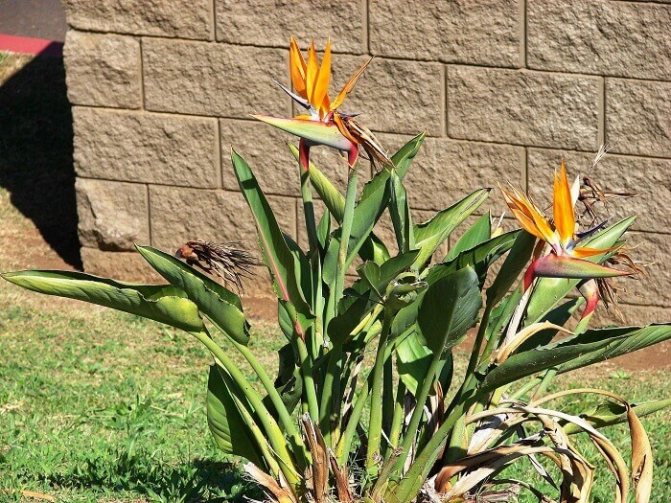

Height... In room culture is 100 - 120 cm., is growing rapidly. In nature, there are individual plants of Nikolai's strelitzia, the height of which can reach 10 m.
↑ Up,
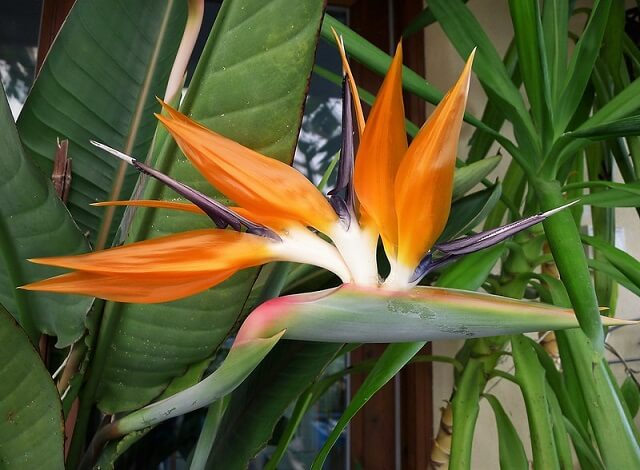

Florist reviews
I began to "roll over", and there I found rotten roots - in general, it was not without "surgical intervention", and since I still had to gut the roots - I planted them in different pots. And in the store there are such great fellows - apparently the roots have crawled through the drainage holes - and they just cut them off. As a result, the holes are clogged with roots, so she is poor and began to rot.
Natusya Regular
For several years in a row, she tried to grow royal strelitzia from seeds. Attempt # 4 was successful. Sowed "bird of paradise" in July, after soaking the seeds for 5 days (or so). In general, I did everything as it was written on the package. I expected seedlings earlier than in 1–2 months, since I made scarification to accelerate germination. As a result, 3 months passed after planting, and no shoots were expected. Once again I was upset, they completely forgot about the pot of seeds. It was found in mid-October, in a corner under the sink. On the surface of the earth there was a small 0.5 cm. Pale green thorn! Joy knew no bounds !!! My royal strelitzia was germinating for 3.5 (!!!!!) months. Of the three seeds, only 1. Now the little ones have grown stronger and are drinking filtered water in moderation.
Evgeniya Anatolyevna
In the spring, I purchased several Royal Seedera stamps. Strelitzia royal reproduces only by seeds, it is impossible to grow it from cuttings and it does not give cuttings or they do not take root. I planted each seed in a separate glass, I took a special soil from the store. She spilled the earth well with settled water, immersed the seeds by about a centimeter, and covered it with glass. I planted it on May 15, after which I prepared to wait a long time, because according to some information, a seed can germinate in 4-6 months. In a month, two sprouts hatched, and eventually a third. I transplanted them into larger containers and they began to develop slowly. Then another one hatched. Hopefully at least one plant will survive to adulthood.
Tanya Tanina
I also grow my seed strelitzia. She is now 3.5 years old. The height is 55 cm, the diameter of the pot is 15 cm. There is no need to give vent to the roots, otherwise it really will have to be transplanted into a tub very soon, but this will not accelerate growth and flowering. If you noticed, she has all the carrot roots at the bottom of the pot, mostly in rings (or you don't have one yet?), And in the upper part there is a much smaller number, and these are mostly thin roots. Let her master the "upper" space with carrot roots! So feel free to plant in "tight" pots, but at the same time try not to damage the thick roots, they are quite fragile! In my opinion, the plant is almost problem-free. Pests were never affected, spraying is not required, the tips of the leaves do not dry. One "but" must be watered carefully ... I transplanted mine into fresh soil at the end of August (it included peat, be it wrong!), After a month of the most accurate watering in the pan I saw any crawling creature: ( Made it on time - some roots have already begun to rot.
Admin
About four years ago I bought strelitzia seeds: two sachets, they contained four seeds. And I didn't process it with anything - I just put the seeds in the ground and that's it. Three of them ascended quickly, and the fourth remained sitting in the ground. Now my strelitzia is already big enough ... two years ago I bought my friend also two bags (four seeds), they came up from her ... she needs light, regular watering and feeding.
Arshi Local
Description of Strelitzia
All strelitzia known today are large evergreen perennials with a powerful aboveground part and the same root system. Thanks to taproots, the plant is perfectly adapted to a lack of moisture. The leaves of some strelitzia species resemble banana ones, but in arid regions, the leaf plates of local varieties shrink, become like an oar, or disappear altogether, turning the plant into a kind of giant, waxy coating of curled porcupine. Strelitzia is adorned with its inflorescences, combining from 5 to 7 orange-purple flowers.


The largest strelitzia, according to the descriptions of the species, reach 10 meters in height. For growing in a room, nurseries of the Republic of South Africa, Australia and other countries choose more compact varieties and are actively involved in breeding work to obtain original varieties and dwarf plants.
Strelitzia flower: characteristic
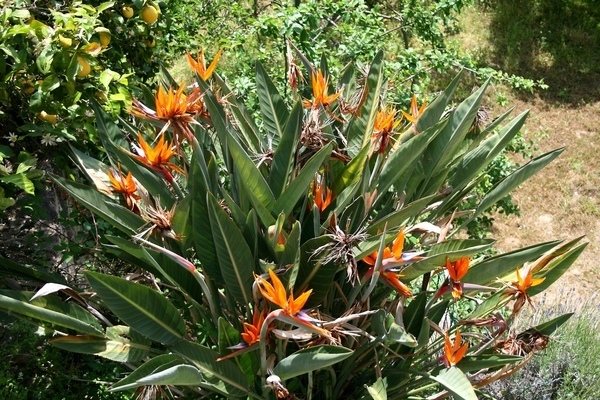

In its natural habitat, such a plant is a herbaceous perennial. Large varieties in natural conditions can grow up to ten meters in height. On average, the bush grows two to three meters.
The root system is in the form of a rod, it sinks deep into the soil. The leaves are oval in shape, with a texture reminiscent of skin. The color of the leaves is green, there is a bluish bloom with a bluish tinge. In its width, the leaf plate can vary from ten to seventy centimeters. The length varies from thirty centimeters to two meters. In shape, the leaves of strelitzia are similar to the leaf plates of a banana palm. At the same time, the length of the petioles is longer, reaching from fifty to ninety centimeters.
The peduncle is long enough, the inflorescences are directed horizontally. The flower can be orange or purple. In the transverse length, the flower grows from ten to twenty centimeters. One peduncle can contain from five to seven flowers. And one bush can have about six peduncles. For this reason, the plant can be in bloom for six months.
If you follow the basic recommendations for the care and cultivation of strelitzia, then a lush and long flowering is almost guaranteed. It happens that a plant blooms more than once a year. Strelitzia is popular in floristry; such a flower is quite expensive. In the cut state, the flower can retain its beautiful appearance from fifteen days to one month.
Strelitzia in interior design and floristry


Strelitzia in interior design photo
Such massive plants will become an appropriate decoration for both dwellings (apartments or houses) and various institutions - in the halls of offices, cinemas, theaters, etc.
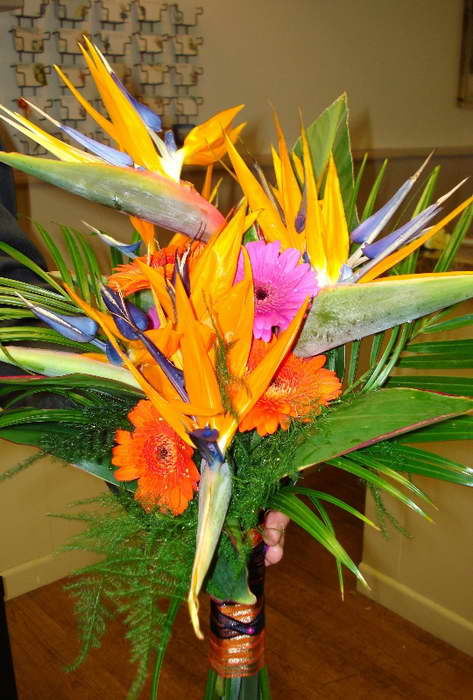

Bouquet of strelitzia photo
Strelitzia inflorescences remain fresh for 1 month after cutting. "Bird of Paradise" in a bouquet will definitely delight.
3. Varieties:
3.1. Royal Strelitzia or Regina - Strelitzia Reginae
Perennial, evergreen, herbaceous plant that can grow up to 180 cm in height. A distinctive feature of the species is that the flowering period can occur several times during the season, if this strelitzia receives proper care. Strelitzia blooms for the first time at the age of 3 years. During the flowering period, the plants form bright flowers in estimates of orange, purple, red, blue, located on leafless peduncles. Peduncles are tough so that they can withstand the weight of small birds - hummingbirds, which pollinate the plants. The flowering period is very long. The leaves are dark green, large, resemble a banana and reach 120 cm in length. The flowers can maintain an attractive appearance for up to two weeks when cut.
↑ Up,
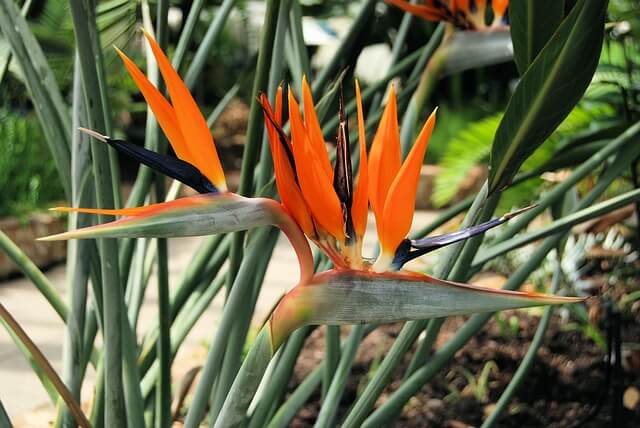

About leaving
Strelitzia care varies depending on the season - watering, nutrition, organization of the rest period and summer residence. But the most difficult thing is to get flowering from the plant.Not all growers have realized their dream: to see the blossoming birds of paradise.


Only the most patient and attentive to the whims of plants, flower growers achieve flowering strelitzia
Watering and feeding
In nature, Strelitzia, a pupil of the African subtropics, is accustomed to seasonal watering. In spring and summer, when the plant is gaining strength and developing rapidly, it needs a lot of water. Moreover, watering is useful to carry out the lower one, through the pallet, so that the root reaches for moisture. After an hour, excess liquid should be removed. The fleshy root does not tolerate waterlogging, but drought will be harmful to it. In the warm season, the soil in the pot should not dry out at all, only the top.
In autumn and winter, if the plant does not bloom, watering is significantly limited. Especially if wintering takes place at low temperatures. On average, strelitzia will have to be watered every 10-15 days. The interval depends on the specific conditions. The soil should dry out on top by 1-2 cm, and stay in this state for 3-4 days.
Irrigation water for strelitzia needs demineralized, previously settled or filtered, room temperature.
During the growth period, strelitzia is fed every 10 days. For young plants, mineral complexes with a high nitrogen content for the leaves are suitable. Adult specimens that are ready to bloom will need potassium and phosphorus fertilizers. After the end of flowering and in the autumn-winter period, feeding is stopped.
About flowering
Birds of paradise inflorescences are a reward for the grower for diligence and understanding, but above all for patience. No matter how hard you try, strelitzia younger than 4, or even 6, will not bloom for years. Some especially thoughtful beauties bloom for the first time only at the 8th year of life. True, if the flowering has already taken place, it will be easier to achieve a second one.
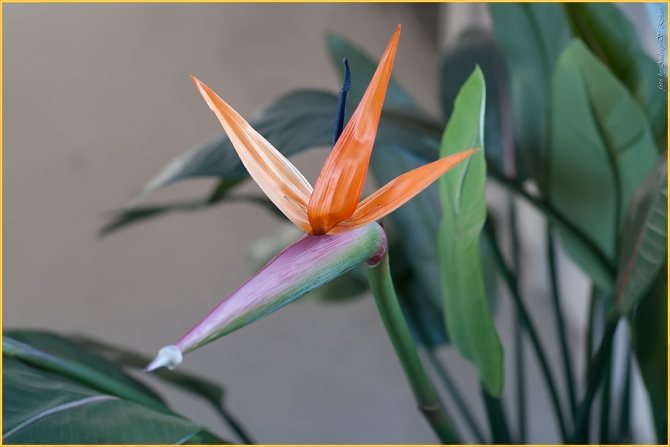

Graceful bird heads only appear on mature plants
Conditions for strelitzia flourishing:
- plant age from 4 years and more;
- a large number of strong leaves;
- developed root system, indicator - new growth;
- cool and dry rest during the rest period;
- bright light for at least 12 hours;
- a cramped pot, but, according to some growers, this is not necessary.
But it happens that all the conditions are met, but the "birds" do not appear. In this case, successful flower growers assure, a shake-up will help - Strelitzia needs stress, which will make her fear for her life and bloom.
Here is one of the extreme experiences that ended with flowering. During the transplant, the old pot had to be broken, and there was no new container where all the roots could fit. Strelitzia stood for about a month in a basin with an open root system and in a semi-dark room. She was finally planted, and after a month and a half, flower stalks grew.
Sometimes it is enough to arrange sparing stress. For example, send it to the balcony in early spring, where the temperature is + 12-14, but there is a lot of light, water very sparsely. Soak in such conditions for about a month. Then bring it into a warm (+ 20-22) room and increase watering, you can feed it with a complex for flowering. To get blooming for the New Year, do the same in early fall.


After suffering stress, Strelitzia can dissolve her wonderful flowers.
As flower growers tell, Strelitzia is favorably influenced by changes in night and day temperatures when kept in the fresh air in summer. After such hardening, it often forms flower stalks. But if you notice buds, don't rearrange the plant pot. New stress can stop flower growth.
Remove flower stalks after wilting, unless, of course, you have pollinated the plant.
Video: what to do to make the plant bloom in winter
Rest
For flowering strelitzia, the dormant period begins after the last flower withers. After removing the peduncle, the plant must be provided with relative coolness (optimally + 12–16 degrees), cancel feeding, reduce watering. But there should be a lot of light. With a short daylight hours, the plant needs artificial sun substitutes.This role can be played by LED or fluorescent lamps. They do not heat the air and shine in the spectrum that plants assimilate. In such conditions, strelitzia must be kept for about 2 months. Then you may see a second wave of bloom.
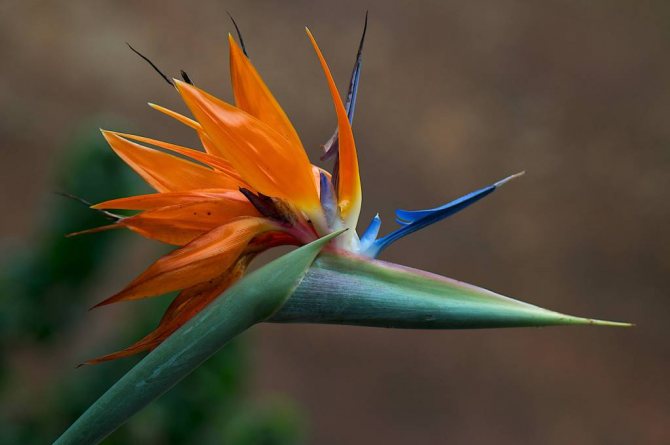

With a properly organized rest, strelitzia can produce flower stalks twice a year.
During cool dormancy, take care of the strelitzia root system. The succulent root can rot in moist and cold soil or freeze. Therefore, the pot must be insulated: placed on a foam support and wrapped in thick material.
If the plant does not bloom, the dormant period for it begins in winter. Try to create the right climate for strelitzia. It is not necessary to increase the air humidity in a cool room. But with a warm winter, Strelitzia needs higher humidity and sufficient watering.
Formation
Strelitzia has no stem. Young leaves unfold directly from the root. Therefore, shaping comes down to hygiene. Old, diseased, deformed leaves must be removed by cutting off the ground. This is necessary to make room for new growth.
Over the years, strelitzia forms basal shoots. If the pot is large enough for a few bushes, you can leave them alone. This will create a fluffier plant. But when the plants become crowded, separate and transplant the young.
About care errors (table)
| How does it manifest? | What is the reason? | What to do? |
| Wet dark spots on the leaves, the petioles rot at the base. |
|
|
| The edges of the leaves dry out. | Air is too dry. | Spray the leaves, especially in hot weather. Humidify the air differently. |
| Leaves turn yellow and wilted. |
|
|
| The peduncle has stopped developing, the buds are dying. | The plant was moved after setting flower buds. | Do not disturb Strelitzia if it has a peduncle. |
| Young leaves grow deformed. | Lack of light or nutrients. | Move the pot to a lighter spot. The plant needs bright light all year round and additional nutrition during the growth period. |
| The plant has slowed down or almost stopped growing. | The root system does not develop due to lack of space. | Transfer the plant to a larger pot and fresh soil. |
Video: caring for strelitzia and again about flowering
What is strelitzia
There are several types of strelitzia. Let's dwell on each of them in more detail
Royal Strelitzia


Royal Strelitzia: Photos
This variety is also called small-leaved. This strelitzia is most often bought by lovers of exotic flowers. In its natural habitat, this plant grows in a forest area located in the mountains of Africa.
In its height, such a bush can grow a couple of meters. The rosettes are quite lush and include dark greenish leaves. Their size is quite large, in length they grow about forty-five centimeters. The edges are wavy.
As for the petioles, they are truly outstanding in such a strelitzia. They can grow up to ninety centimeters. The flower petals are dark blue on the inside and orange on the outside. In their length, the flowers grow by about fifteen centimeters. Flowering occurs, as a rule, twice during one year.
Strelitzia Nicholas


Photo of Nikolay's Strelitzia
This species grows in its natural habitat in Africa. Strelitzia feels best in mountainous and forest areas with a tropical climate.In appearance, such a plant looks like a banana palm.
It is a woody plant that can grow up to ten meters in height. The base of the strelitzia resembles the trunk of a palm tree, as it is covered with scars left after the foliage has died.
The peduncle has four elements, which are colored green and reddish. The outer part of the petals is white, the inside is blue. In their length, they grow by about seventeen centimeters.
Mountain strelitzia
In its natural habitat, such a plant grows in southern Africa. This is not a very common plant. This is a tree-like strelitzia, which can reach a height of about ten meters. Large leaves. They are arranged in two rows and encircle the bottom of the plant base around the perimeter. The flowers are quite large, painted in a white tone. The bracts are pointed at the ends, painted in a red tone. In their length, they grow up to forty-five centimeters.
Reed strelitzia


Photo: reed strelitzia
In its natural habitat, this species grows in eastern Africa. Such strelitzia calmly tolerates a dry season, and is also not so sensitive to sudden temperature fluctuations. The flowers are similar in appearance to the flowers of another variety of strelitzia - royal. But there is a difference in the leaves. The reed strelitzia has very narrow leaves. The leaves are grouped into a dense rosette. In transverse length, it can grow about two meters.
Soil and fertilizing
The best soil should contain peat, leafy and soddy soil. You can purchase special soil or use regular potting soil.
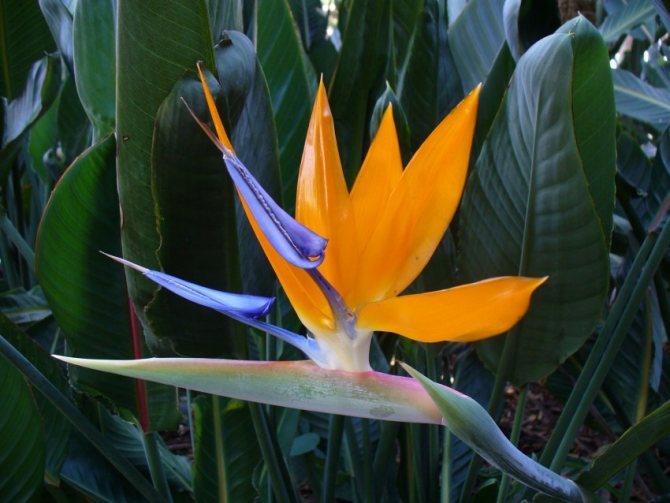

The introduction of top dressing is simply necessary: it will allow the plant to grow well, be strong enough and eliminate the need for a dormant period.


Views
At the moment, five types of strelitz are known, and the last (fifth) was opened (described) only in 2019.
Royal strelitzia
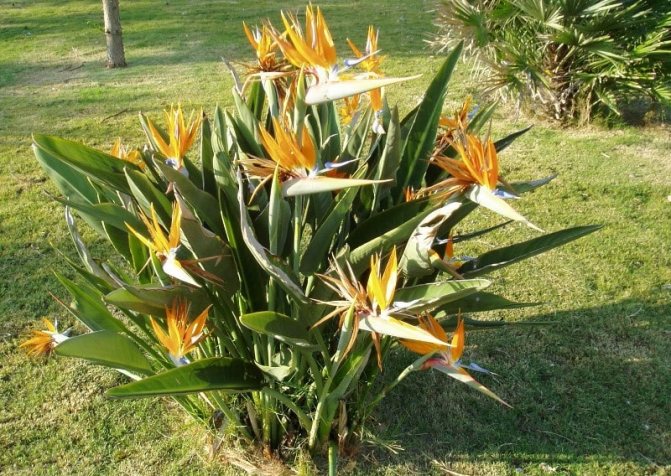

Strelitzia royal or bird of paradise (Strelitzia reginae) is one of the species of the genus Strelitzia, a beautiful plant with which the whole genus is associated, because it is he who is cultivated at home, although extremely rarely due to the difficulty in breeding and the high cost of adult plants. In nature, it grows up to 3.5 meters, but rarely in an apartment, but reaches 1.8 meters (on average up to a meter). But this is also a lot, so in an apartment, adults are usually grown in a pot on the floor - the window sill is clearly small for them.
This species is the ancestor of the entire family, discovered at the end of the 18th century and named after the crowned wife of King George III of the United Kingdom of Great Britain and Ireland, Sophia Charlotte of Mecklenburg-Strelitzkaya.
Strelitzia leaves are evergreen, resemble banana in shape, with an elongated ellipsoidal shape. The length of the leaf itself, without the stem, is 15-40 cm, and the width is 10-30 cm. The stem can reach a length of 50-70 cm.
Flowering is very long and can last up to six months. Flowering begins in winter, continues in spring and ends in summer. Peduncle is rather long, cut-shaped, erect, strong. Flowers on it are yellow, purple, blue and orange. Each "queen" can have up to six peduncles. The petals are similar to the crest of a fabulous bird, hence the second "popular" name - the bird of paradise. Each peduncle has about seven flowers. If you take proper care of Strelitzia at home, it can bloom several times a year.
Strelitzia "bird of paradise" reproduces mainly through growing from seeds, as well as by children and dividing the bush. The second option is an extremely rare method, due to the fact that it gives very few children, and then only after 3-5 years of growth. By cuttings, it does not reproduce at all due to objective reasons - the absence of a trunk and branches. Getting seeds at home is also extremely difficult.Therefore, there are two ways left: buy seeds or, if there is an adult plant, divide the bush, but only after flowering.
Can be grown indoors in the Moscow region, the Urals and Siberia.
Strelitzia Nicholas
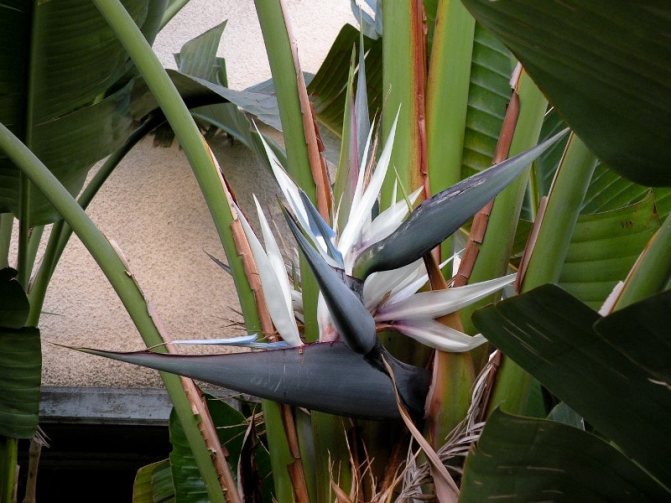

This species received its name in honor of the Grand Duke, the son of Nicholas I - Nikolai Nikolaevich, on the initiative of the managing director of the Imperial Botanical Garden, who grew the seeds brought to him in the conditions of the northern capital.
The homeland of this species is located in the Republic of South Africa in the Cape province, in the very south of the African continent. Today, its distribution area extends from South Africa to Zimbabwe and Mozambique.
In nature, Nikolai's strelitzia can grow up to 10-12 meters in height (on average 5-6 meters) and up to 3-4 meters in width in a spreading crown. Local tribes call it, because of the similarity in appearance, - "wild banana Natalya", although genetically Nikolai's strelitzia has nothing to do with either a cultivated or a wild banana. The plant has a treelike pseudo-trunk, really reminiscent of a palm tree due to the special scarring that appears after the foliage and fan-like top fall off.
Large inflorescences have a common shape with all strelitzia. The reddish-blue wrapper boats contain white sepals with dark blue petals. The whole composition of the flower resembles a bird's head with a white tuft. Wrap boats can be up to 50 cm long. The peak of flowering occurs in spring and early summer, although it is year-round. Many inflorescences are always formed on the peduncle. In its natural environment, it is pollinated by the sunbird bird. The seeds are decorated with orange "terry".
The leaves are huge (up to 2 meters) dark green with shine, are located on elongated cut-like stems, creating a spreading crown. In strong winds, they are often torn, which further creates the illusion of wings movement during the flight of a fabulous bird.
Strelitzia nicolai is drought-resistant, but does not tolerate severe frosts, therefore, it is almost impossible to meet this plant in natural conditions, characterized by sharp jumps in temperature.
A feature of this species (unlike its counterparts) can be considered the fact that its unripe seeds can be eaten, and local residents make strong ropes from dried stems for personal needs.
Reed strelitzia


Strelitzia juncea - similar to the royal, but with the main difference in the shape of the leaves, which look like "needles" in it, growing in a fan-shaped rosette and resembling a reed. This similarity gave the name to the variety - reed.
The difference between the leaves of the two species did not affect the similarity of flowers; they are practically identical in reginae and juncea. Identical peduncles and flowers for a long time did not allow the reed strelitzia to develop into a separate species, leaving it at the level of the royal strelitzia hybrid. But in 1975, a scientist from South Africa R.A. Gyr proved the genetic difference between s. juncea and s.reginae. Thanks to the research of a South African botanist, the reed strelitzia acquired the status of an independent species.
Strelitzia juncea is drought tolerant and can withstand light frosts. It grows slowly and flowers, as a rule, appear on it only after four years, but it blooms throughout its life, which is not so small for it.
Propagated mainly by seeds. Unlike other species, it will not work to propagate it by dividing the bush. But you can cut out a part of the plant in the center of the bush along with a piece of root and plant it. At the same time, neither the donor bush nor the recipient will suffer from this.
Strelitzia white
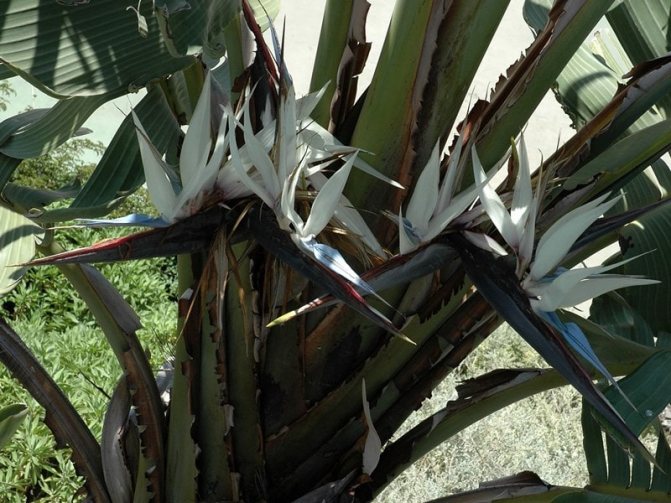

Strelitzia alba is a large (up to 10 meters) plant with a tree-like, palm-like trunk. Leaves with colors from green to grayish, reach a length of one and a half to two meters, and grow up to half a meter in width. The bracts are purple to black, and the sepals themselves are white.
Strelitzia Augusta (another name for "alba") has a powerful rhizome, which, in principle, is characteristic of all gingerbread plants. It does not tolerate a lack of watering, but it is quite stress-resistant with respect to temperature changes. It can be grown at home if a lot of space is allocated for it, both for the ground part and for the root.
Mountain strelitzia


Strelitzia caudate is a massive plant with a tree-like trunk (the name of the trunk is conditional, the plant is still herbaceous) and huge leaves. It can grow in natural conditions up to eight meters in height. The leaves are beautiful with a smooth surface and distinct central and lateral veins.
The desert banana (as this species is also called) has huge, somewhat unique flowers with large wrappers (up to 45 cm) and three sepals, white in color and petals of different sizes, fastened to each other.
Mountain strelitzia is a rare species, endemic; it grows in the natural environment in South Africa and does not occur outside the African continent.
How to achieve flowering
Strelitzia over 5-6 years old blooms regularly, even several times per season. To be sure to see the flowers of the bird of paradise, you need to plant the plant in a spacious pot and provide a cool dormant period. For 2-3 weeks, the plant is kept at a temperature of + 12 ... + 14 ° C, and then brought into the heat. After 3-5 months, the first flowers will appear. Cooling can be ensured not only in winter. If you find a cool place in the summer, then Strelitzia will bloom flowers for the New Year. Also, bright lighting and regular watering are important for flowering.
How to transplant strelitzia


How to transplant Strelitzia photo
Young plants need annual replanting, which should be done in early spring. This will stimulate growth and encourage further flowering. Adult plants (over 4 years old) should not be disturbed once again with transplants, because the root system is fragile and fragile - with severe damage, the plant will take root for a long time.
It is enough to transplant an adult strelitzia once every 4 years, so immediately choose a spacious container, and be sure to lay a drainage layer on the bottom. For adult plants, it is recommended to renew the topsoil every spring by introducing a humus-peat mixture.
Please note that the root system develops more deeply, the capacity is required deep enough, but also wide for stability.
- We put a layer of expanded clay on the bottom for drainage.
- The soil requires loose, nutritious, slightly acidic or neutral reaction. A mixture of peat, humus and river sand, prepared in equal proportions, corresponds to these characteristics.
- Remove the plant carefully from the previous container. Shake off the ground and inspect the roots - if there are rotten parts, they must be cut off and the cut points should be treated with a fungicide (phytosporin).
- While the roots are ventilated, pour the required amount of soil over the drainage layer, then set the plant in the center of the pot and fill the voids with substrate.
- The root collar should be at the same level as before.
- Squeeze the soil around the stems with your palms and water the flower a little.
The technology of growing a flower of paradise from seeds
Relative cold resistance does not allow cultivating decorative strelitzia in open ground conditions in most regions of our country, and the plant is grown as a room culture. The plant is one of the rather rare among domestic flower growers., which is due to the specificity of culture reproduction. Seed material of Strelitzia shows stable germination only when freshly harvested and cannot be stored for a long time.
The seeds of the ornamental plant Strelitzia need preliminary preparation in the form of soaking in water at a temperature of 35-40 °. After swelling, sowing is carried out in individual planting containers with a volume of 0.2 liters with high-quality drainage holes.The soil substrate should consist of one part of compost, one part of peat and one part of coarse, clean river sand. After filling the seedling container by three quarters with soil, a layer of wet sand is poured on top, into which the prepared seeds are buried. The crops should be covered with plastic wrap.
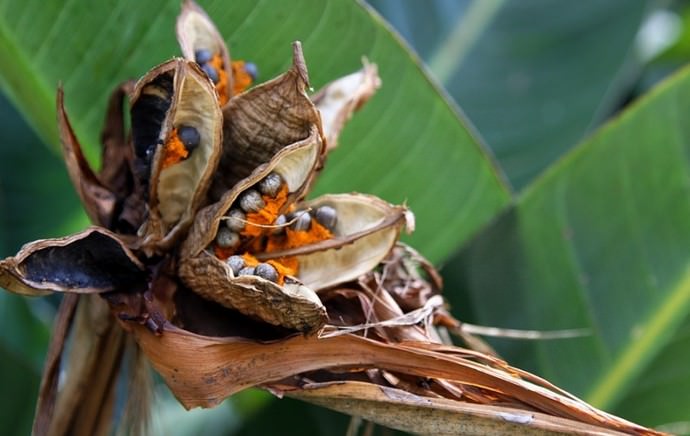

Until the first shoots appear, depending on external conditions and species characteristics, it can take a month and a half or six months. The room temperature must be maintained at 22-24 ° C throughout the germination period of Strelitzia. Containers with crops should be placed in a place shaded from direct sunlight. It is possible to remove the film cover only after the first true leaf appears on the seedlings.
Further care of young Strelitzia plants consists in regular irrigation measures. After the plant is large enough, transplant into a flower pot. It is important to remember that the pot must have high-quality drainage holes. Plants need to be transplanted very carefully, due to the presence of thick, but fragile roots. Strelitzia begins to bloom in the fourth or fifth year after sowing the seeds.



